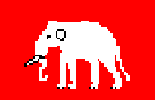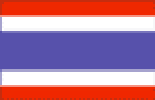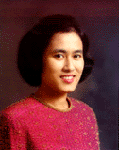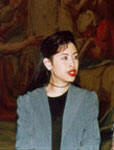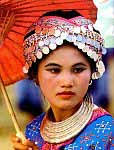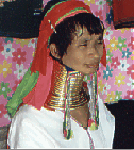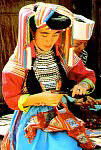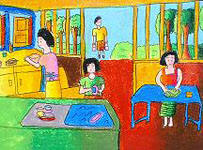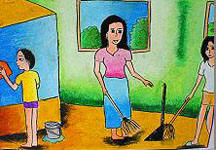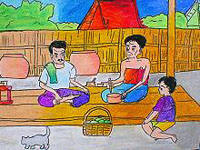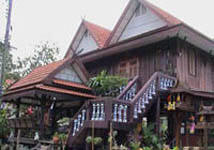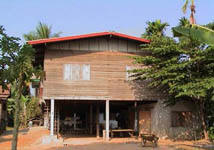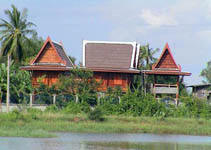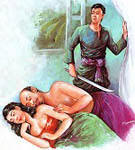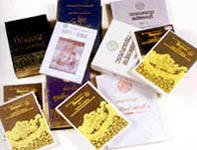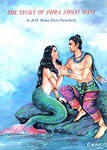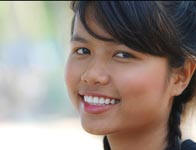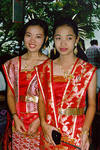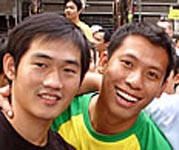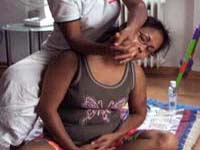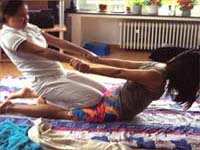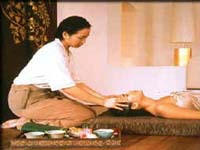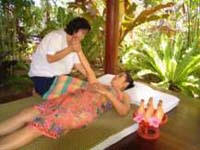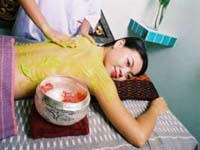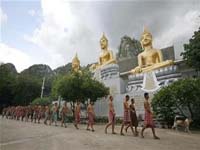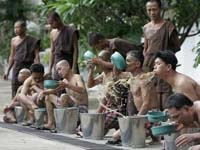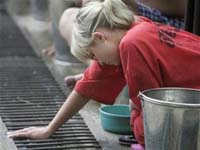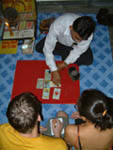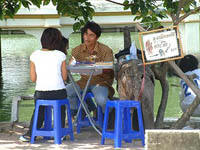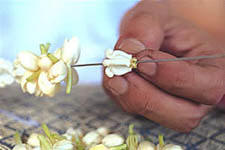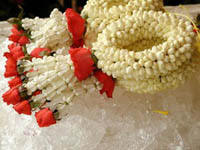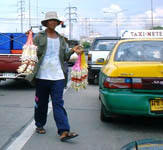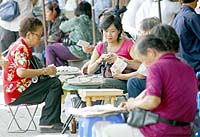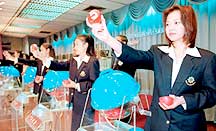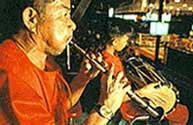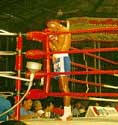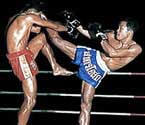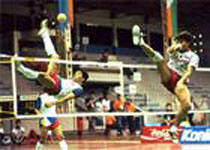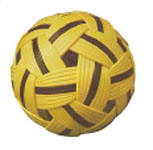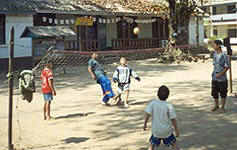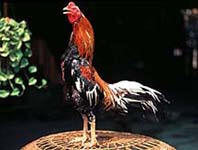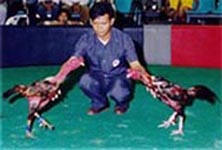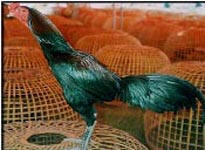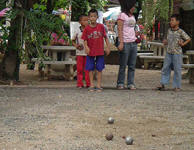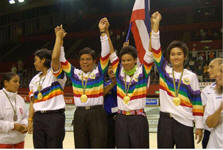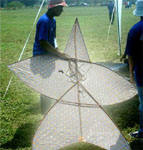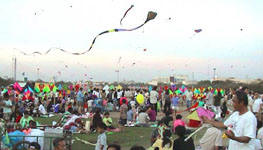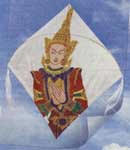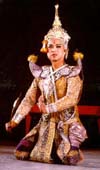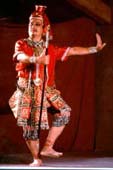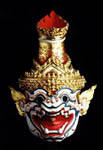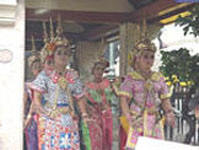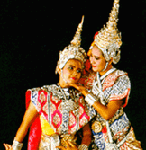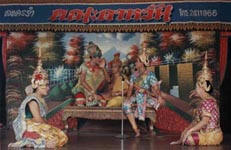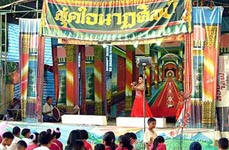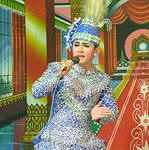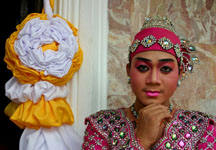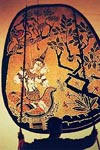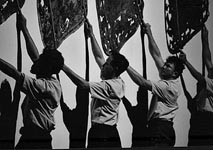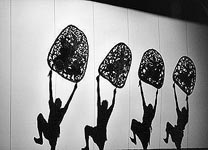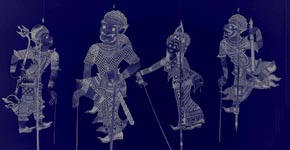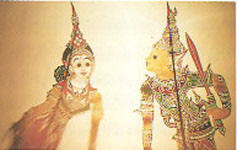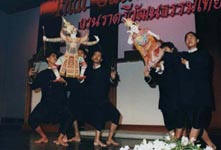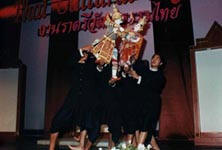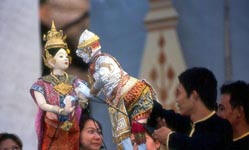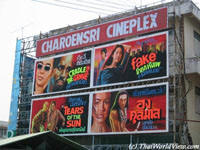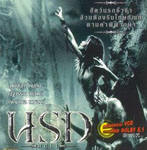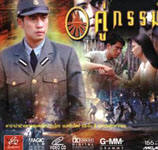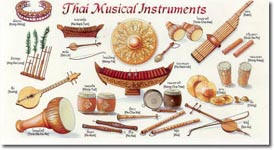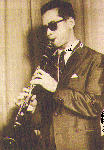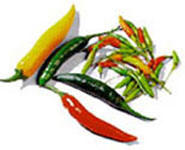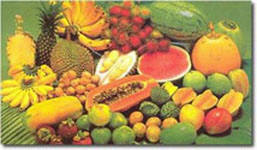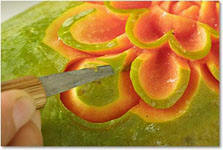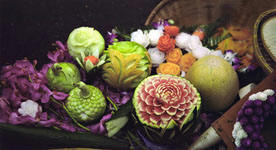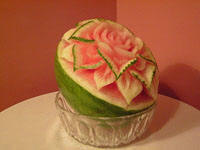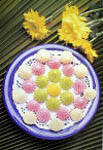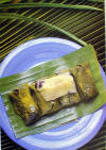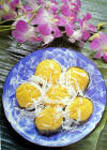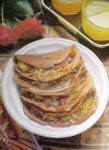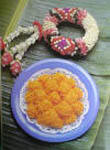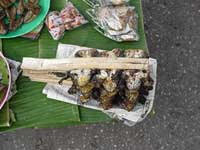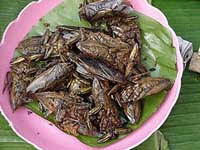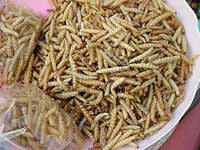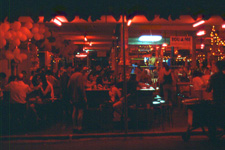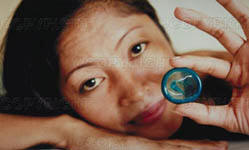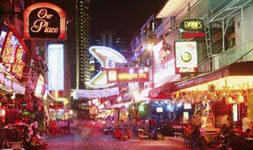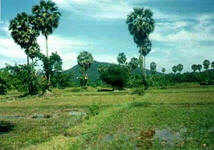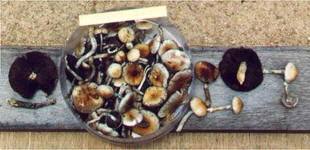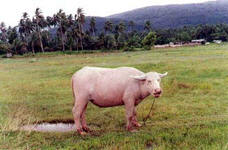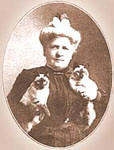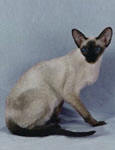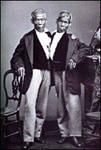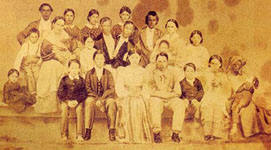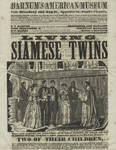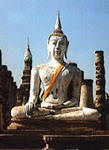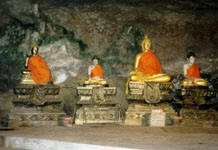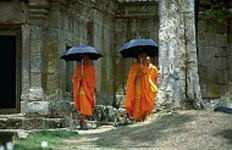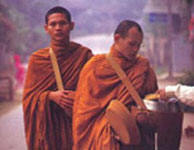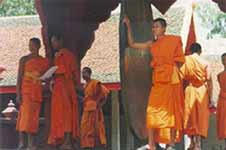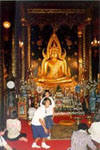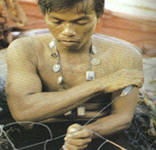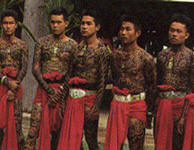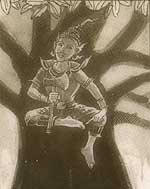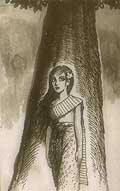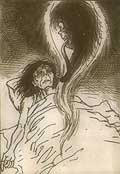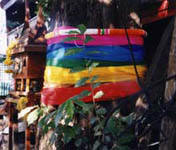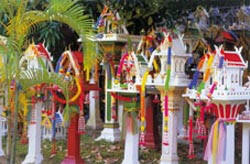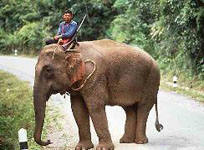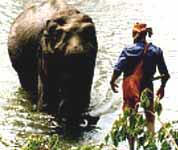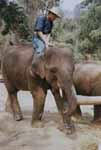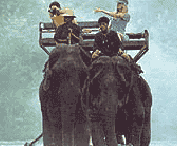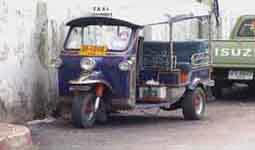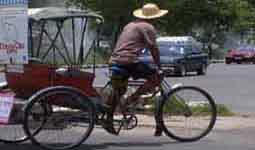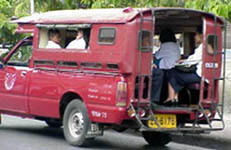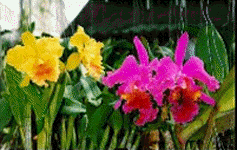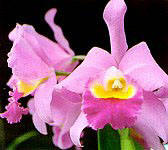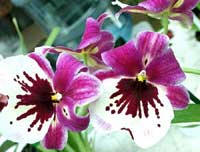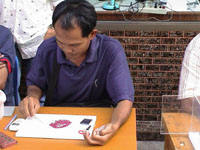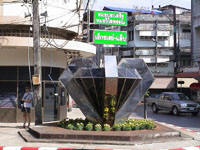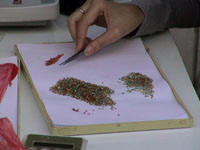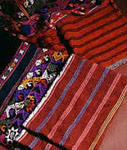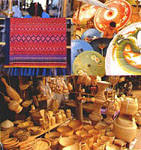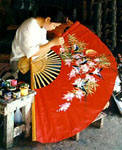![]()
THAI CURIOSITY
|
SAWASDEE |
|
The salute
When the thais peoples are met, they don't tighten the hand. The habitual salute is the "wai", with the hands committees like in order praying. For tradition and say "sawadee", more high come held the hands, more respectful is the salute, thus is easy observing two persons, to guess which it's their relative rank. But the rank is a complex matter in thailand, because depends on many variable ones, like the age, the occupation and the social position. For a foreign is sufficient to make the gesture.
|
|
|
The flag
The flag of Siam was originally a white elephant on a red background. However, in 1916 King Vajravudh was touring a flooded region and saw the flag flying upside down as a distress signal. Since he didn't like the idea of the national flag being used in that way, he designed a new flag that was symmetrical and would not look different if turned from top to bottom. The new flag was adopted 28 September 1917. The only country in Southeast Asia to remain independent during the colonial period, and until 1939 officially known as "Siam" (now Muang Tai, "Land of the Free," or Pratet Tai, "Free Kingdom"), Thailand has been strongly influenced by both China and India but is fundamentally a sub-Indian civilization, based on Buddhism and using a version of the Devanagari (Sanskrit) alphabet, adapted from Cambodian. A Buddhist historical Era is still used in Thailand. In fighting with Vietnam for influence over Cambodia and Laos, the Vietnamese were not even regarded as properly Buddhist, because of the more Confucian basis of Vietnamese government. Nevertheless, Siam was more closely in contact with China than with India, has long been the home of a large Chinese community, and in 1575 even requested a new royal seal from China, to replace the one lost to the Burmese in 1569. So we really have a phenomenon of Indian and Chinese cultural spheres overlapping. It is noteworthy that both Laos and Cambodia were vassals of the original Bangkok kingdom but were lost to the French colonial empire in Vietnam.
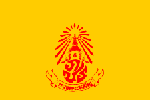
|
|
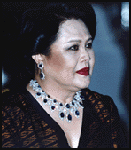 |
|
|
|
|
|
The Royal Family
The Chakkri dynasty has reigned in Thailand since 1782. At the dawn of the 20th century, the country then called Siam was ruled by King Chulalongkorn, who was the son of Mongkut, the king portrayed by Yul Brynner in "The King and I." Chulalongkorn abolished slavery and otherwize modernized the country. He died in 1910 and was succeeded by two of his sons, one after the other first Vajiravudh and then, in 1925, Prajadhipok. In 1935 the throne passed to Prajadhipok's nephew Ananda Mahidol. When he died unexpectedly in 1946 (shot under unclear circumstances), his younger brother became king. That brother, Bhumibol Adulyadej, known as King Rama IX, is still alive and has reigned longer than any other living monarch, although his real power is limited. The king and his wife, Queen Sirikit, have been married since 1950. They have four children, Princess Ubol Ratana, Princess Maha Chakri Sirindhorn, Princess Chulabhorn and Crown Prince Maha Vajiralongkorn, who is heir to the throne.
The King's flag recently saw in Thailand was quite different from the royal standard in FOTW (Garuda on yellow background). The King's flag is his crown shape and his Thai character initial in red below on bit dark yellow. The shade of yellow is the same as of Thai Monks clothes or that used in the Sri Lankan flag.
|
|
|
|
|
|
The population
The Thailand has a population approximately of 61,000,000 of habitants, 75% belongs to the group ethnic thai, subdivided in four fundamental ethnic: thai of the center or siamese of the delta of chao phraya, thai lao of the northeast, thai pak, thai of thailand southern and thai of the north. Everyone speaks its dialects thai and possesses own customs. The thai people of chinese origin are 11% of the entire population, they are of the second or of the third generation, of the etnia hokkien (hakka), tae jiu or cantonese. In the north is present also a number rather numerous of than hui, chinese muslim who immigrated of the yunnan (china region) in thailand, about the end of the past century, for to escape to the ethnic and religious persecutions, during the dynasty ch'ing. The second large ethnic minority resident in thailand is that malese 3' 5%, remaining 10.5% of the population subdivided in smaller groups of languaged not thai, like the vietnamese, khmer, the mong, the samang, the moken or gipsy of the sea, the htin, the mabri, the khamu and a variety of approximately twenty nomad tribe that live on the mountains near Burma and Laos borders.
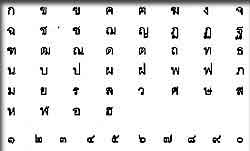
Thai language
The Thai script has, like many others, its deepest roots in the Brahmi writing. The direct predecessor was the so-called Pali Squared script. This was taken around 1283 under the reign of king Ram Khomheng of Sukhothai to develop the old Thai (Siamese) script, which has probably been heavily influenced by the Khmer alphabet. The alphabet has changed its style drastically during the centuries until finally resulting in the modern Thai alphabet, which exists in the current form since the 17th century. The oldest known document in Thai is a Buddhist cosmography called Traiphum that dates into the 14th century. The Thai alphabet consists of 44 consonant glyphs, two of which are no longer in use - they were abandoned for lack of space on the first Thai typewriter keyboards. Often several glyphs represent the same sound, a result of the phonetic change of the language: In earlier times they represented different sounds that later fell together and merged into one. The 44 characters thus encode a total of 21 different consonants. Eight of the characters appear exclusively in words of Pali or Sanskrit origin, but not in originally Thai words. At the end of a syllable not all the sounds are permitted, the only phonemes acceptable there are [k], [p], [t], [m], [n] and [N]. This means that all other consonants are changed into one of these sounds in final position. In addition to these characters there are four consonant-vowel-combinations. In order to help children learning the alphabet, the characters are usually called by their name followed by a word beginning with that consonant. All consonants include an inherent followed: [a] in monosyllabic words and the first syllable of disyllabic ones, [o] in the second syllable of disyllabic words. For the display of other vowels there exists a whole range of diacritical signs for simple vowels, diphthongs and even triphthongs. These are placed on all sides of a consonant; there are diacritics that sit above a consonant, others are put behind, below, before and in the case of some diphthongs even framing the consonant from front and back. Consonant clusters are considered as one entity, therefore in such a case one finds a "left-standing" vowel in writing two signs before the consonant behind which it is spoken. As Thai words can start with a vowel, but there are no independent characters for vowels, one of the consonant characters is a place-holder without a sound of its own that serves in such cases as "bearer" of the initial vowel. The Thai language disposes of five different tones that are marked in writing. However, this marking is done in quite a complex way: Every consonant bears one tone in an open syllable (ending on [m], [n], [N], or vowel), one in a closed syllable (ending on [p], [t], [k]) with a long vowel, and one in a closed syllable with a short vowel. These three tones can be partly the same ones, but are usually different. According to these tones the consonants are grouped into three classes called "high", "mid", and "low", representing the different "tone schemes". The mentioned consonant-vowel-combinations fall in none of the classes. In addition to that, there are tone marking diacritics for open syllables that change the "base tone" of the syllable as given by the consonant. The direction of the tone change is again a function of the consonant class. There are as well numeral characters for the ciphers, but the "Arabic" ciphers as used with the Latin alphabet are nowadays also widespread. The Thai script has no punctuation marks, but disposes of special characters that mark a word as abbreviated or repeated. Another character stands for "and so on". Thai letters are not connected to each other, and usually texts are written without spaces between words. A space marks normally the end of a phrase or clause, but it is also possible to write whole texts without any spaces. The high number of characters, the numerous possibilities for vowel positioning and the complicated tone marking make the Thai script relatively difficult to learn.
The local customs
The thai people are too much tolerant and jovial for expect that a foreign (farang) knows and respects their uses, but also can being of aid here to know that is o.k. and that is not o.k. the things that can irritate the thailandesi are the lack of respect for the monarchy, the king is untouchableand in past even he was considered sacred; is the protecting one of the nation and also i add master of ceremonies of all the buddhist rituals. To the symbols of its authority due the maximum respect. To speak about the real family is tabu'. To touch one currency or one banknote with the feet is a crime of lese majesty because on it is portray the king. Also the lacked respect of the buddhist religion and its symbols is considered annoying, we begin from the sacred symbols, like the representation of the buddha in whichever shape; treat with not deference is a serious sacrilege. It never does not have lean to a buddha statue, in the past some foreign were made to photograph seated on the head of one great statue of buddha, a double insult, because the head is considered the more sacred part of the body. In the temples (wat) every people must remove the shoes before entering in the building with the main image of buddha, of which the faithfuls seat on the pavement rendering homage, a woman is watched balefully if she enters in a temple, in short or with others parts of the body discovered. The monks are untouchable, a women do not have touch for no reason, she can't deliver they directly something, if happen that a woman must give something to a monk and there are not men in the vicinity, in order to make give through, the woman must to put the object on a table or the pavement and when she moved the monk pick-up the thing.
|
|
1000 BATH |
|
10 BATH |
|
|
500 BATH |
|
5 BATH |
|
|
100 BATH |
|
1 BATH |
|
|
50 BATH |
|
50 SATANG |
|
|
20 BATH |
|
25 SATANG |
|
|
10 BATH |
||
Thai money
Thai unit of currency is the baht. One hundred satang equals 1 baht. Paper money is made in amounts of 10, 20, 50, 100, 500 and 1,000 baht. Coins are 1, 5 and and 10 baht pieces and also 25 and 50 satang. The king's face is pictured on the front of every coin and every bill. At the moment, it's about 47 baht per 1 Euro.
|
|
|
|
Thai Rural Family
Perhaps the best way to comprehend Thai social values is to focus on its basic unit, the Family, and in particular the rural family in its typical village setting. Generations living under one roof, or at least under several roofs within the same compound; and it is here that the Thai child learns codes of behavior that will guide him throughout much of his later life, whether it is spent in the village or beyonds.
In a village, home is usually a simple wooden house rased on posts; domestic animals like buffalos, pigs, and chickens are kept below, and the family lives above, often in a single room. There is little privacy, though this is not as highly regarded as in Western countries, and the communal lift style instills a strong sense, of social harmony in which tact, compromise, and tolerance are essential. The father is regarded as the leader, but the mother also plays a significant role, particularly in the f amily finances.
The coastline of the East is being developed into the so-called Eastern Seaboard, which will be a center of industrial development in the future.
When small, children are treated permissively by various members of the family, which as likely as not will include grandparents and sometimes more distant relatives as well. Respect for elders is taught very early, however, and by the time a child walk s he is aware of his position in the family hierarchy, a distinction that applies not only to the relationship between parents and children but also to that between siblings of different ages. This same delineation of roles also applies to the wider worl d outside the family and will remain deeply ingrained throughout life, thus explaining the reluctance of younger Thais to oppose or otherwise confront a senior during their subsequent careers in business or government.
A sense of responsibility is also inculcated in early childhood. Each child is assigned certain duties according to age and ability-feeding livestock, leading the family buffalo to graze in nearby pastures, taking care of younger brothers and sisters w hile parents are at work in the fields. As they grow older, responsibilities increase and they are allowed to paticipate in family discussions, with their opinions taken into account when important decisions are made.
One of the prime responsibilities placed on children is that of taking care of parents in their old age, a prominent feature of the Thai concept of family. There is no felling of being inconveniened by this duty of caring for aged parents; on the contra ry, their acquired wisdom gives them an honored place in the household, and their counsel is actively sought in teaching their grandchildren and great-grandchildren to be responsible adults with the same traditional values.
Village Organization and Leadership
Beyond the family, the next larger unit of social organization is the village. Although there are regional variations in house styles and crop cultivations, and the setting may vary, in essence Thai villages are remarkably similar, revolving around well -defined climatic, religious, and farming seasons.
The typical village contains around 100 to 150 households, or an average of 500 to 700 inhabitants. The houses are nearly all simple wooden structures, elevated on stilts as protection against flooding and unwelcome animal intruders and also to improve air circulation. A small wooden granary, also on stilts, is often found beside the house, together with large earthenware jars in which rainwater is stored for drinking. Most villages now have electricity but water for washing and cooking comes from ca nals, rivers, or ponds, or, in the arid northeast, from communal wells.
On the village outskirts are the local school and the wat, or Buddhist monastery, sometimes adjacent to one another, sometimes at opposite ends of the village. The school is generally a simple wooden building, perhaps a single room where several classes are held simultaneously; an essential feature is the flagpole upon which the Thai flag is ceremoniously raised each school morning and lowered in the evening. The monastery, constructed and maintained largely through local donations and thus reflectiong the village's wealth, is often separated from the community by an open field to give the resident monks maximum privacy and seclusion for their relgious activities. This grassy expanse also serves as the village common, a place where children assemble t o play kickball and where local fetes are held.
The village is self-governing, led by an elected headman, or phu-yai-ban, who until recent years was always a man; since 1983, however, women have also been eleted to the position. A candidate is not affiliated with any political party but must be a lit erate Thai house holder who has resided in the village at least six months and be at last 25 years old. If he retains the villagers'esteem, the phu-yai-ban can remain in the post until retirement at 60 through repeated reelections; by the same token, he c an be removed if he forfeits their respect.
The phu-yai-ban preserves the social harmony valued so highly by all Thais by skifully settling minor disputes, talking care to ensure that neither party feels cheated or loses face. In addition, he keeps the village birth and death records and acts as a spokesman for the community in negotiations with the government bureaucracy.
Administratively, neighboring villagers are organized into groups known as tambon which, depending on topography and population density, consist of two to 28 villages. The phu-yai-ban within each tambon elect one of themselves to be kamnan, or commune h ead-person. Thailand has nearly 5,000 tambon at present. The kamnan is chairman of a committee which often includes a government school headmaster, an agricultural extension worker, and sometimes a Health Department doctor or paramedic in charge of a lo cal clinic. It also contains at least two men selected by the nai amphoe (or district officer, who is the kamnan's immediate superior or appointed by the provincial governor.
This committee is responsible for deciding which villages should have new roads, irrigation budgets and health services, while the kamnan's main individual responsibilities are to see that justice prevails within the commune, to maintain records and stat istics, to help preserve peace, to assist in collecting taxes, and to act as the intermediary between the district officer and all village headpersons in his tambon.
The wat serves as a social center where villagers have both religious and recreadtional activities.
The wat is the focal point of the village, symbolizing the Buddhist religion and also acting as the major unifying element, particularly during festivals and merit-making ceremonies when it also becomes a social center for young and old alike. Abbots an d senior monks frequently enjoy more prestige and moral persuasion than the village head, and in times of personal crisis they are often the first whose advice is sought. Within the wat the abbot has absolute administrative, clerical, custodial, discipli nary, and spiritual responsibilities, and they determine the monastery's relationship with the village. If an abbot is scholarly, meditative, and retiring, the monastery is unlikely to concern itself much with mundane village affairs. On the other hand, if one is a dynamic personality he may make the wat a community center with a subtle but powerful influence on social action. Every young man in the village, before he starts his own family, will spend a period of study and reflection in the wat, thus i ncreasing the influence of Buddhism.
|
|
|
|
Thai Houses
The Thai house, like other houses in Southeast-Asia, is a wooden structure raised on posts. Over many centuries it has acquired its own unique style. The distinguishing marks are an elegantly tapering roof and various finials and decorations that differ regionally. While architectural features vary throughout the four cultural regions, Central Thailand, the North (Lanna), the North-East (Isaan), and the South, the method of raising a platform on poles is common to all parts of the country.
In the central
Most traditional Thai houses in the central plain that have survived to our time are similar and nonvaried in the main styles. The majority of them were built between some one hundred to one hundred and fifty years ago. They are known for high gabled roof, "panlom" or gabled roof panel, generously wide eaves, ample space underneath the house on stilts. Thai houses in the central plain come in different categories. Thai house for lone family unit, Thai house that does business on the dry land, residence for royal personages, and living quarters for Buddhist monks. Thai house in the central plain has its roof line oriented along east west direction. This is to cut down the amount of sun light into the main body of the house and at the same time obtain the maximum benefit of the cool winds.
In the nord
The Lanna or the northern people favor the valleys that are the river basins for settlement. The northern region which begins from Sukhothai all the way to Chiangmai and Chiangrai is dominated by mountains and rain forest. The year round climate is the coolest of all regions. The typical house in the north is rather well walled in with less space for windows, and ample space for platform known in the northern dialect as "toen". A shelf for a row of earthenware water jars is to be found on one side of the house. The walls tend to be slanted toward the eaves the main body of the house is usually surrounded by large open space. Close to the house, fruit bearing trees and "sompoi" known for its leaves that are used in the rites of the northern people are grown. Lanna house as a rule faces east with the roof ridge oriented along north south direction. The house is thus exposed to ample sunlight and at the same time protected from northern winds in the cool season. The house of the north falls into three main categories i.e. tied house (reuan kruang pook), hard wood house (reuan kruang sab or reuan mai jing or reuan katae) and the house in a mixed style between the traditional and the western ideas. Tied house represents the true tradition of the house of the northern people. Supporting posts and beams are in hard wood while the walls are made from juxtaposed bamboo slats. The roof cover itself is made from large leaves or reeds. Reuan kruang sab or reuan kalae to which similar to reuan krunag sab is built from hard wood introduced during the reign of King Rama V, the house in the mixed style between local and western is richly decorated with carved and cut wooden fleeces also known as the "sala nai" style.
In the northeast
Thai House of the northeast are built with due considerations for dryness, hot temperatures in the hot season and cool temperatures in the cool season. The geoeconomic conditions and believes also play their parts in the evolve of the house styles of the northeast. Early northeastern villages are relatively small and widely scattered over the entire region. The passage of time sees rice farmer families numbering from 100 to 400 gradually gather to from bigger villages. The typical village is crisscrossed by walkways along the length and width of the village dividing it into groups or "koom". Each koom is given a name for the purpose of record and registration. There are to be found in a village, a school a rice mill and a village court of law and a reservoir. The layout of the houses in each koom gives no hint of symmetry or systematic planning. The orientation of the roof of each house is invariably along the east west direction. The space between one house and the next is not fixed, but on the average about four meters. Most if not all houses are without fences. Each house is accompanied by a granary built close to the house either to the north or south of the house. The average house is designed for a single family. The house plan is simple consisting of a bed room, corridor, a kitchen, and a shelf for shoring water. Some houses may have "ruan kong" added ti the main house. Ruan Kong is a hall room built opposite to the bedroom. Most houses have no partitions and assigned areas are not clearly marked off one another.
In the south
Thai houses in the south are quite similar to those found in other regions of the country. There are ruan kruang pook (tied house), ruan kruang sab (wooden house) both of which have undergone development which gives the southern people the cement brick house. Their peculiarities are supporting posts resting on stone slabs to prevent termites attack, and dampness from the ground seeping through. The space under the house is rather generous while the roof is set rather low. This design makes the house better withstand strong winds and rains. The slant of the extended roof allows rain water to run off the roof quickly and help the roof to get dry quickly also. The alignment of the supporting posts and the walls are slanted inwards. The style known as "Elephant in a urinating posture" is thought to make the house absorb the impacts of strong winds more effectively, permits easy ventilation and at the same time protect the ground under the house from collecting an excessive amount of rain water. The walls are made of wooden boards arranged in such a way that the upper board overlaps the lower one to prevent rainwater running through the wall on the inside of the house. Thai house of the southern region has its longer side oriented in the east to west direction known in the dialect as "pluk baan loi wan" meaning setting the along the south to north direction. Doing so would expose the house to full sun light almost half a day and also to strong winds which are liable to blow from east to west directions. The alignment of the granary is the opposite of that of the house. By setting the longer side of the granary along the north south direction, the paddy in the granary will get all sun light it needs to get dry. The granary of cause is more sturdily built than a regular house. Thai house in the south is built as a single unit for one family's living. When the family grows large, another house is built along the main house together with a platform linking the two houses into a single unit. The platform area of Thai house in the south is small an narrow compared with the same of Thai houses in other regions. This is probably due to frequent rains in the south and narrow or small platform helps one to move from one house to other in as short a time as possible and hence get least wet. In some areas of the south, brick work or even an earth mound is built to the level of the platform and use for growing flowers or small plants such as promagrenade, orange lime, vegetable or perfume wood plants. The roofs of Thai house in the south come in four major styles i.e. gabled, "panyah" "kabranoh" and manila.
|
|
|
|
Thai Traditional Literature
Thai Traditional Literature is essentially religious. Most of the literature in the old days consisted of works on Buddhism and Hinduism directly or indirectly. Whatever culture the Thai people brought with them from thier homeland in Southern China where they had been in contact with Chinese culture for centuries was adapted to its later conception of Buddhism, their adopted religion. Traces of their original culture may be found here and there in a disguised and weak form embedded in their literature. Most of the works of emotive literature were written in veerse in various patterns. Five prominent examples of such works may be cited briefly.
The Romance of Khun Chang Khun Phaen, an indigenous story of love and pathos, at time humourous, of a triangular love plot of one heroine with two lovers. The story, apart from its beautiful expressions, contains a mine of infomation on old beliefs and social customs of the Thai before the impact of Western culture. The story as is known has been traslated into English and French.
Ramakian (or Ramakirti in transliteration) is the story based on the famous Indian epic, Ramayana. It is unique, containing many episodes and details which are not to be found in the original epic, but showing traces of contact with certain versions of the Ramayana in India, Malaysia, Java and Cambodia. There is an English translation.
The Romance of Inao. This is a translation from the well-known storty of adventures of the national Javanese hero prince. It is written in a refined and perfect style of the Thai Language and meant for dramatic performance.
Sam Kok. This is a translation from San Kuo Chi, a Chinese historical romance of the Three Kingdoms. Unlike the three preceeding ones, it is written in prose with perfect expressions of style of the language.
Phra Aphai Mani. This is a romantic tale written in verse by one of the most famous and popular poets of Thailand. It is an imaginary tale of love, intrigue and adventure, and reflects some ideas of the people towards the Europeans of the last century. There is an English translation in concise form by one Prem Chaya.
The employment of prose in Thai emotive literature along the lines of the Western style is of recent date due obviously to the influence of Western literature.
|
|
|
|
In pubblic
Is normal to see two thai males to walk hand in the hand for the road, sign of friendship not more, while is rare to see a man and one woman hand in the hand, because to manifest in public attraction or affection for the other sex is an ancient and strongest tabu'. During the war of the vietnam, when bangkok was full of soldiers americans in licence, the more frequent critic ' that came turned they, regarded their behavior in public with the girls of the bars, that it was of the all innocent if reported to the models americans. The experience has left traces deep and the girls of good family are not little whom they avoid also of being seen in company of one foreign " farang " in order not to be object of the eventual depreciation of the compatriots. In the relations with the thai, remembered of smile always, of being always kind, repressing every wants of to express your feelings, not demonstrated to the sympathy and to the aversion, the smile for the thai is much that a way to communicate: is a way to exist that it joins various ethnic and it fascinates the foreign visitor. Never not touched the head to nobody, neither to a child, because in it reside the spirit and considered spirit and therefore is a sacred part of the body. The foot is low part of the body, in considered of that in thailand is mistaken to indicate someone with the foot, especially if it is make of purpose. The thais thus are preoccupied of this eventuality that avoid of to overlap the legs; if just they cannot make less, hold the tips turned towards earth.
The names
The last names are a particularly recent innovation for the thailand, being be only introduced fifty years ago, before then, the persons were called with the single name, necessary continuation if, from one explanation of the type " son of " or "of the city of " also today last names thai thus long and are complicated to be used very rarely; thus miss. Pruksachart wanchan comes called simply miss. Wanchan. " khun ", in language thai, is the equivalent mr, mrs. And ms., and it's used for the men who for the women. Between persons of various age, for respect in front of the name, it comes put " pi " if the word to one addresses a old person and " nong " if the word to one addresses young person . Moreover in thai are used words in order to express feelings rather than meanings. Two of such words are the particles "krap" (used from men) and "ka" (used from the women) in order to make affirmations and questions. Of extreme courtesy, they would have to be taking place pronounced after every demand and answer. Often the thai omit moreover pronouns "poom/chan" and "kun" (you), for an ulterior touch of discretion.
The expressions
There are three expressions thai to remember: " mai pen rai ", " pai-tio "and " sanuk ". Nobody of the three can be transate in english with exactitude, but is very important in order to understand the heart and the character of the thai. "mai pen rai" can to never become in english with " don't worry ", if forgotten something that you had said to make for a friend, he answered to your excuses with " mai pen rai ", meaning " don't import, don't to think, you stay calm ". This expression suggests beyond that one specific reaction at one situation, an mental attitude.. In so far as to be seen like an extension of the philosophy buddhist, one shake of shoulders for the petty things. For sure a type of western mentality can to be an attitude exasperating, above all when it is applied to things that we consider important. For other can to make part of relax atmosphere that we find in thailand. The reluctance of anxiety for the things, above all for the things on which one does not make nothing, the tendency to accept the difficulty, the preference for the smile rather than for the tears." sanuk" means amusement, the love that the thai have for the "sanuk", their joy of living, it are deeply takes root and pervade all the aspects of the daily life without to become no account, they stretch to divide the experiences of the life in that it are "sanuk" and in that it are not "sanuk". To go to the cinema, one festivity, a wedding, to make a visit to an old friend, to eat one cup of "noodles" in a good restaurant, to make a travel ect...is "sanuk". The job instead is not "sanuk", at least in the case that is monotone and critical more if it is "serious". A company japanese manifacturing, tried of to reproduce the production techniques that worked very well in japan, but the thai inexorably were "bored" with the routine and since the trouble is not "sanuk", the company to come on the hem of the failiture. When the company put a little "sanuk" in the production system, cable broadcast, intervals in order to make one dull, play and contest between the several units, the things began to go for the best. The passion of the thai for the "sanuk" is not indicative of one frivolous mentality or a refusal to be confronted with the aspects less pleasant of the life, is instead revelation of a inveterate sense of joy, without it the life would be reduced to the eyes of the thai in something of meant wishy-washy and without significance. The thai when is necessary know to hard work, observed the team work in the roads, with the women who raise the same weights of the men under the burning sun, the workers of the roads, with every probability will make jokes and invent something in order to render pleasant the daily routine. To the thai does not interest a job without "joy". "pai tio" means to take a walk without a particular scope, to go to see what happens in turn, to take a air puff, to approach to the cinema in order only for see the people go in, it means a infinity of similar but various things. The place for "pai-tio" are the more dissimilar, the typical are the markets, where all go to buy something or in order to see only. Every time you see a thai outside of house or outside the place of work, except the case that has a engagement serious and important, is much probable that he is going "pai-tio".
The conversation
Is necessary to say a word, on purpose of curiosity that the thais manifest for the things that from we are not considered conversation arguments. After the thai little known a new person, for example can ask you:" how much coast your shirt? ", or " which is your wage?"; or "how old are you?"; or if you are married and, if you are not " why?". Questions of the sort, for how many personal, are not considered indiscreet, but simply a sign of interest; the same things would ask them an other thai. Is always necessary not to give the exact answer; you can also not to answer, on condition that accompanies the refusal to answer with a smile in order to demonstrate to not be offenses. A " farang " resident to bangkok give always the same answer to the concerning questions how much earns. Smile and says: " not enough.
|
|
|
|
|
Massage The second and most internationally famous type of Thai medical terapy is raksaa thaang nuat (massage treatment). The extensive and highly refined Thai massage system combines characteristics of massage (stroking and kneading the muscles), chiropractice (manipulating skeletal Parts) and acupressure (applying deep, consistent pressure to specific nerves, tendons or ligaments) in order to balance the functions of the four body elements (thaat thangg sii). These four elements are earth (din-solid part of the body, including nerves, skeleton, muscles, blood vessels, tendons and ligament); water (naam-blood and bodily secretions); fire (fai-digestion and metabolism); and air (lom-respiration and circulation). Borrowing from India's Ayurvedic tradition. Some practitioners employ Pali-Sanskrit terms for the four bodily elements: pathavidhatu, apodhatu, tecodhatu and vayodhatu. From the Ayutthaya period until early this century, the Thai ministry of Public Health included an official massage division (phanaek maw nuat). Under the influence of international medicine and modern hospital development, responsibility for the national propagation/maintenance of Thai massage was eventually transferred to Wat Pho in Bangkok, where it remains today. Traditional massage therapy has persisted most in the provinces, however, and has recently enjoyed a resurgence of popularity throughout the country. Within the traditional Thai medical context, a massage therapist (maw nuat, literally, "massage doctor" usually applies Thai massage together with pharmacological and /or psycho-spiritual treatments as prescribed for a specific medical problem. Nowadays many Thais also use massage as a tool for relaxation and disease prevention, rather than for specific medical problems. Massage associated with Bangkok's Turkish baths (aap op nuat or "bathe-steam-massage" in Thai) is for the most part performed for recreational or entertainment purposes only (or as an adjunct to prostitution); the techniques used are loosely based on traditional Thai massage. For problems affecting the nerves rather than the muscular or skeletal structures, many Thais resort to nuat jap sen (nerve-touch massage), a Chinese-style massage technique that works with the body's nerve meridians, much like acupuncture.
|
||
|
|
|
|
Traditional Thai medicine
Western medical practices are for the most part restricted to
modern hospitals and clinics in Thailand's towns and cities. In villages and
rural areas a large number of Thais still practice various forms of
traditional healing which were codified in Thailand over 500 years ago.
Clinics and healers specializing in traditional Thai medicine can also be
found in urban areas; many Thai doctors in fact offer a blend of
international medicine-a term ethno-medical scholars prefer to "western
medicine"-and indigenous medical systems. Traditional Thai medical theory
features many parallels with India's Ayurvedic healingtradition as well as
Chinese medicine. In practice, however, Thai diagnostic and therapeutic
techniques may differ-significantly. Obviously influenced to some degree by
these traditions, Thai medicine in turn has been the predominant influence
on traditional medicine in Cambodia, Laos and Myanmar. Most Thai medicine as
practiced today is based on two surviving medical texts from the Ayutthaya
era, the Scripture of Diseases and the Pharmacopoeia of King Narai.
Presumably many more texts were available before the Burmese sacked
Ayutthaya in 1767 and destroyed the kingdom's national archives. A
coexisting oral tradition passed down from healer to healer conforms to the
surviving texts; other materia medica developed in the Ratanakosin (or old
Bangkok) era are founded on both these texts and the oral tradition. Like
medical practitioners elsewhere in the world, traditional Thai physicians
perform diagnoses by evaluating the pulse, heartbeat, skin colour/texture,
body temperature, abnormal physical symptoms and bodily excretions (eg.
blood, urine, faeces) of their patients. Unlike orthodox western doctors,
Thai healers favour a holistic approach that encompasses internal, external
and psycho-spiritual conditions Thus, once diagnosed, patients may be
prescribed and issued treatments from among three broad therapeutic
categories.
Herbal Medicines
Traditional pharmacological therapy employs prescribed herbs, either singly
or in combination, from among 700 plant varieties (plus a limited number of
animal sources) which are infused, boiled, powdered or otherwise rendered
into a consumable form. Common household medicines (yaa klaan baan in Thai)
include the root and stem of baw-raphet (Tinospora rumphii, a type of
woodclimber) for fever reduction, raak cha-phluu (Piper roots) for stomach
ailments, and various yaa hawm (fragrant medicines) used as medicinal balms
for muscle pain or headaches. Medicines of this type are readily available
over the counter at traditional medicine shops and to a lesser extent in
modern Thai pharmacies. More complex remedies called yaa tamrap luang
(royally approved/recorded medicine) are prepared and administered only by
herbalists skilled in diagnosis, as the mixture and dosage must be adjusted
for respiratory infections and influenza-induced fevers. As in the Chinese
tradition, many Thai herbs find their way into regional cuisine with the
intent of enhancing health as well as taste. More information, please see
also Thai herb in same page.
Psycho-Spiritual Healing
A third aspect of traditional Thai medicine called raksaa thaang nai (inner
healing) or kae kam kao (literally, "old karma repair") includes various
types of meditation or visualisation practised by the patient, as well as
shamanistic rituals performed by qualified healers. These practised in
conjunction with other types of treatment. With the increasing acceptance of
meditation, hypnosis and biofeedback in Occidental medicine, anthropologists
nowadays are less inclined to classify such metaphysical therapy as "magico-religious",
accepting them instead as potentially useful adjunct therapies. As in the
west, psycho-spiritual techniques are most commonly reserved for medical
conditions with no apparent physical cause or those for which other
therapies have proved unsuccessful. In Thailand they are also occasionally
employed as preventive measures, as in the bai sii ceremony popular in
North-Eastern Thailand and Laos. This elaborate ceremony, marked by the
tying of string loops around a subject's wrists, is intended to bind the 32
khwan or personal guardian spirits - each associated with a specific organ -
to the individual. The ritual is often performed before a person departs on
a long or distant journey, based on the reasoning that one is more
susceptible to illness when away from home.
|
|
|
|
Wat Tham Krabok
An obscure Buddhist monastery in central Thailand (Saraburi province) that advocates a secret herbal potion and ritual vomiting for drug addicts has become a final source of hope for thousands of Thais and Westerners. Since its foundation in 1959, Wat Tham Krabok, 140 km (85 miles) north of Bangkok, has put nearly 100,000 addicts through its "cold turkey" detox program and given them a grounding in meditation to help them keep on the straight and narrow. Dressed in red hospital-style overalls, patients have to stay for a minimum of 10 days, during which they are subject to a strict regimen of leaf-sweeping, steam baths, herbal medication and group vomiting. Sitting in the shadow of an imposing limestone crag, the monastery was founded in the late 1950s by a group of monks who decided to renounce all earthly pleasures and live out the rest of their days in a cave.However, the military rulers of the day, keen to rid the capital of its opium dens, encouraged them to accept a large plot of land in return for taking care of the drug addicts the army was booting out of Bangkok. Using a complex herbal medicine whose ingredients were revealed to the aunt of one of the monks in a dream, the monastery started treating its first opium addicts in 1959. To this day, the 100-odd ingredients of the thick, dark potion that lies at the centre of the detox program remain a secret known only to Tham Krabok's abbot and medicine monk. According to Phra Hans, the potion draws toxins out of the patient's body and into the stomach. The quickest way to get the toxins out of the stomach is for the patient to drink large quantities of water and then vomit. In what is now a well-choreographed ceremony, patients sit cross legged and side-by-side in front of a long open drain. Accompanied by drums and chanting they then try to drink a bucket of water before sticking their fingers down their throats. "Everybody who comes here must come as a warrior, ready to fight for their life."
|
|
|
|
Fortune Telling
One popular, easy to access and quick form of fortune telling is siem si ('chiam si') or fortune sticks. Siem si , developed by the Chinese, is probably one of the most ancient ways of predicting the future. In Thailand we normally see this type of oracle at Chinese temples or shrines. People who seek advice begin by praying to the deities, asking for guidance with their problems or answers to their questions. They then shake a wooden vase-like container filled with a number of long thin sticks. Each stick has a number indicating the number of an advice slip. The first stick to fall to the floor is the fortune. The next step is tossing a two-part woodblock. Different positions of the pieces confirm the number. The Thai way of life is based upon Buddhist religious beliefs as well as the animistic elements of Brahmanism and folklore. As a result, religion has become a mixture of philosophical, mythical and supernatural elements, all of which deeply influence one's way of life. Just as some people go to see the doctors to treat their physical ailments, some Thais go to fortune - tellers (Maw Du), the all seeing doctor to cure their spiritual ills. and prevent future maladies. Fortune - tellers are engaged to give auspicious names to a baby according to his exact birth calculations. Weddings, investments, travel, car purchases, building construction, traveling and other significant decisions in life, are all directed by the fortune - teller. There are many forms of fortune - telling: palm reading, star charts, playing cards, physical features, spirit mediums and high - tech computerised fortune - telling. Fortune - tellers can be found in many places - under the shade of the trees like the tamarind trees around Phramane Ground, next to the Grand Palace, in the markets, in the hotel lobbies and plazas, etc. Most can be identified by small altars with offerings of flowers and lighted incense dedicated to various deities who have given them with the skill and knowledge of this art.
|
|
|
|
Phuang Malai
Thai garlands called "Phuang Malai". Flower arranging became increasing popular during the reign of King Rama V. The ladies of the Court spent many hours in arranging flowers. Each lady taught her own designs to her ladies - in - waiting, and to the young girls who lived in the palace and received their "finishing school" education under the patronage of the Royal ladies. Until recent years, vendors usually sat in front of the entrance of themarket and some vendors travelled up and down the lanes in Bangkok and in some big cities, balancing a woven tray filled with colorful filled with colorful garlands on top of their heads. Calling "Phuang Malai, Phuang Malai" as they went, one needed to go only to her/his front gate to buy the fresh garlands. A lovely new garland would be given to the spirit house or to be placed reverently at the base of the Buddha images in the family shrine. The most common way of making "Phuang Malai" is by threading the variety of petals and flowers on a cord with the use of a huge needle. Garlands can vary widely in design as the whims of the "manufactures" cause them to mix and match - colours and flowers. The type of garland most commonly given to greet arrivals, or to farewell friends and relatives, are those with two strands of flowers connected by a length of ribbon with bows or rosetters attaching the ribbon to the flowers. These are called "Uba". This type of long garland is seen at shrines or statues such as at the shrine of Thao Maha Phrom on the corner of Hyatt Erawan Hotel. It has many designs but the similarity lies in the long length, resembling a chain or necklace.Vendors selling a variety of flower garlands are always found near temples, shrines, statues or even near street intersections. A mother and small children sit while they busily string the garlands. Young and old become proficient at their work.Garlands are presented and worn at many festive and happy occasions, such as graduations, birthdays and weddings, for good luck. It is customary in Thailand to have a portrait of a deceased person displayed near the urn or coffin. A lovely flower garland with a black ribbon is placed at their base as a mark of respect and final farewell. The honored personage who performs the ribbon cutting ceremony of "grand opening" is presented, on arrival with a lovely flower garland most often the shorter, bracelet design.Wherever and whenever their Majesties go - as well as other members of the Royal Family - throngs of people line the way with flower garlands to present to them, as a token of their love and respect.
|
|
|
|
Thai Lottery
Lottery first started in Thailand in the reign of King Rama V. It was first drawn in an international exposition arranged in the King's birthday celebration. Again in 1917, a lottery drawing was arranged to finance Thailand's entry into World War I on the Allied side. Next, lottery was used to finance the Thai Red Cross charity works expenses in 1932. Lottery was first drawn to really generate revenue for the government in 1934 to finance the short fall in government income due to the abolishment of draftee tax, levied on Thai males who wished to forego compulsory military service. The drawing was implemented by the Revenue Department. In the same year, lottery operation was also introduced to the provinces to finance the provincial municipality operations. In 1939, the control of government lottery operation was transferred to the Ministry of Finance with the appointment of the first lottery board by the Ministry of Finance on April 5, 1939, which is now held as the founding date of the Government Lottery Office. In the same draw, it also issues two million tickets for sports promotion and seven million for other charity organization. To produce the lottery tickets, the Government Lottery Office operates a modern, large-scale printing press, which also handles printing jobs for other government agencies as well. Each year, the Lottery Office turns in over 4,000 million bath to the government treasury. It also provides 440 scholarships of 20,000 baht each for undergraduates and earmark eight million baht a year for various charities. The office also contributes close to 20 million baht a year for the welfare fund of civil service and military personal, Welfare Council of Thailand, and the War Veteran Association. Future projects of the Government Lottery Office includes a plan to computerize lottery buyers service that visualizes purchasing of lottery and prize payment by commercial banks' country-wide network of automated teller machines. The Office also commits itself to increase its support for public service projects. In Thailand, you’ll have to get lottery tickets from agents, which receive these tickets from retailers. It is still paper-based material while many other countries have developed an electronic system to organise the lottery tickets. Usually, lottery tickets are drawn twice a month, which are the first day of the month (the 1st) and the 16th. Every ticket costs 80 baht. This is the standard price. Each ticket has 2 parts, the top and the bottom part. It is not possible to buy just one part as they come in pairs. So, every ticket will still cost you 80 baht. However, if you win, your prize is doubled. Every ticket has 6 single digits, which you’re able to choose when you buy one. When the numbers are drawn live on national television, there are probably more than 20 drawn every time as they’ll have to draw all of the numbers according to the number of prize stated.
Now, the prizes and amount of these lotteries are as follow
First Prize
1 number 2 million baht
Second prize 5 numbers 100000 baht
Third prize 10 numbers 40000 baht
Fourth prize 50 numbers 20000 baht
Fifth prize 100 numbers 10000 baht
Bonus prize* 2 numbers 50000 baht
* Bonus prize is for people whose first 5 numbers are correct but the last digit is incorrect by one number above or below. (For example, if your last number is "5" you can get the bonus prize if it is a "4" or "6". If you win a prize, you’ll have to go to the GLO (Government Lottery Office) where you will receive a cheque. However, if the prize is less than 20,000 baht, you can go to a local agent and he/she will give the money to you in cash. There is tax, which you’ll have to pay in order to get the money. The nominal rate is 50 satang (0.5 baht) for every one hundred baht. If you cash your money at a local agent, they’ll normally charge you about 2 baht for every one hundred baht.

I want to talk about how to watch out for a fake lottery, which could be sold to anyone. Here are the steps.
A fake
lottery has characteristics as follow
- different color from the original
- different paper
- no watermark
A prize is drawn the same day as the national lottery. Here is what it looks like: There are 3 prices of these tickets, 20, 50 and 100 baht. The first row is for 3 single digits lottery. The prize is set to a standard at 500 baht per one baht. For example, if you win the correct amount in the same order and your ticket is the 100 baht ticket, you’ll get 50,0000 for the prize. However, there’s a second Tote row, which the numbers shouldn’t have to be in order and you can also win. The prize of this tote row is 10 baht for every one baht. For this kind, there will be 4 prizes drawn every time. For the third row, you can choose 2 single digits and if you win, you’ll get 65 baht for every one baht. However, you can also choose the last row as it would be a reverse row and if you win that, you have halved the prize money.
|
|
|
|
The thai boxe
The blows forbidden does not exist in famous "muay thai" (science of the eight limbs), because concur to use the hands, the feets, the elbows and the knees. The practisings are all young, because in this massacring sport the career finish to the maximum to 25- 26 years,the encounter carries out in 5 round of three minutes everyone, during these minutes an orchestra of four elements, comprising a cingalese flute, cymbals and a pair of long drums, accompanies the dance and the combat following the action and marking the time as the encounter is ignited. The boxers are considered the warriors and heroes of the thailand, this sport e' sure the preferred one. The women amuse how much the men and when there are important matches in television, all remain " nailed " in front of the television set. If the western is impressed from the violence of the clashes, for the thais the boxe is a true and just ritual, a cult. Often the monks to train the future champions who, before beginning the match, kneel down themselves in prayer to the center of the ring and execute some steps of dance in order to show in shape stylized their ability. When the boxers make their apparition on the ring, beyond to the shorts and the gloves, they have a colored rope around the head and to the bicepses with an amulet and often a crown of jasmines around the neck, moreover they have the nude foots. The origins of this sport then go back to the times of the glorious reign of siam (xiv century), the legends tell of thrones and reigns conquered with kicks, fists and knees of ardent principles, when still the referees did not exist and the hands came protect from rough stripes of burlap.
|
|
|
|
Takraw
Takraw is played in various versions in most parts of Southeast Asia. But perhaps no where else is this startling game, in which players must neither touch the ball nor let it touch the ground, played with the enthusiasm and vigour shown by Thailand's star performers. Games are played in the courtyards of wats, at fairgrounds, and (particularly during the kite flying season when there is little or no rain) at the Pramane Grounds in Bangkok. The small and hollow rattan balls which are the essential-and sometimes only necessary equipment for a game are sold in rattan shops and sporting goods shops throughout the country. While there are certain basic rules to takraw, the game varies according to the type of takraw being played as well as the place where it is played. In village games, for example, there is often no referee and no source is kept : the winning player is simply the one who puts on the best show. The intricacy and speed with which it is played are astonishing, and if you think your reflexers are better than average, consider these methods of sending the ball aloft : the sole kick (using the arch or sole of the foot), the instep kick, knee kick, shin kick, shoulder kick, or head kick. Want to try the crosslegged jump kick? That consists of crossing your left leg over your right and leaping up to kick the ball with the instep of the left foot. Another version is the crosslegged knee kick. In this one the player crosses his left leg over his right above the right knee, and then leaps, into the air kicking the ball with his right knee. But that's not all. One can use elbows, shoulders, even the posterior. The more complicated and impressive your feats, the better your score (Or, if a score is not being kept, the better your audience's reaction : spectators can be demanding, if not downright ruthless, in their judgements). One of the most difficult of all acts is seen in a game of hoop takraw, The player makes a hoop of his arms behind his back, and kicks the ball with his heels through the hoop in such a way that it also passes through a hoop suspended in the air. (if you groan at the thought better not try it). Hoop takraw seems to be the most popular version of takraw in Thailand. A team usually consists of seven players (there can be no less than six) who stand at the perimeter of a circle. During a 30 minute period, the players cooperate with each other to earn a high score. Hoops are suspended over the centre and the players must hit the ball through them. Successive teams try to surpass the previous score. Net takraw is somewhat like badminton, in that it requires a net and a court. Lots are drawn beforehand to determine placement of the players and the first serve. Near the net, the ball is then tossed to a teammate in the middle of the court, who kicks it into the opposite camp. The game then proceeds at an incredible pace as the ball is returned instantaneously sometimes to great heights. Some players wear rubber plimsolls, while others are barefoot. Net takraw is played in teh SEAP Games (now we call SEA Games) and other international competitons. The Thais introduced it to the SEAP Games while the Myanmar introduced the variation called imitation ring, where in a player takes a particular position to toss the ball and all other players must imitate that position. Apart from net and hoop takraw, other variations are popular in Thailand. One of these is in-tossing takraw, which has far less rules to abide by : the point is simply to see how many times the ball can be hit aloft by the player. It is a means of training for a player. Some can hit the ball from positions which call for stooping or lying down. A good player should be able to keep the ball aloft for ten minutes, and if he is joined by others the group should manage to keep it in play for close to an hour. Naturally, this is a skill which only the most adept players can manage : they have trained arduously and are able to concentrate for a long period as well as to use their bodies dexterously.
|
|
|
|
Thai fighting cock
The two major thai fighting cock
variaties, are namely the leung hang khao (yellow body white tail) and the
pradu hang dam (brown body black tail) cocks.
Thai fighting cocks are well-known throughout the asian region for their
beauty and fighting skills. Thai fighting cocks originated in south east
asia, developing from the red jungle fowl, which are present in thailand,
myanmar, indochina and the philippines. The breed has been maintained by
thai breeders who select and develop the breed for cockfighting.
In the olden days cockfighting was not confined to rural areas. During the
ayudhya period (19th century ) prince naresuan, while held hostage by the
burmese, brought with him the leung hang khao cock to compete with the
burmese prince. Prince naresuan's brother, prince ekathosaros, also enjoyed
the sport of cockfighting using the breed pradu hang dam.
The leung hang khao cock originated in the northern part of thailand ( ban
krang village, phitsanulock ), and is spread throughout thailand and south
east asia. The standards of perfection for leung hang khao breed is
determined and described from prominent traits of the cock, ranging from
general physical features, behavioral patterns and fighting styles.
The leung hang khao breed is a middle size bird averaging 3.00 kg. To 3.5
kg. For a cock and only 3.0 kg. For a female. The cock is covered with black
feathers but from the back of the skull to the end of the body, the feathers
are yellow-red, which varies according to different varieties. As the name
implies, its long tail is white especially on the top part. The female bird
is slightly shorter and covered with black feathers dotted with white.
The pradu hang dam is the ancestor of the japanese "shamo" which was brought
into japan at the beginning of the 16th century. In indonesia, thai fighting
cocks are so popular that they are known as bangkok ayam.
The pradu hang dam refers to brown cocks with black tails. It is another
genuine thai breed originating from lower central thailand. Both male and
female pradu hang dam breeds are slightly bigger then leung hang khao but
the physical features generally look almost the same, except for the color.
There is also a wide variety of pradu hang dam breeds distributed across the
country.
In thailand today cockfighting is still a popular sport, especially so in
the rural areas where cockfighting has always been a part of life. Most
village households raise fighting cocks in their backyards for sport and
also for their firm and tasty meat.
|
|
|
|
Pétanque is a form of boules where the goal is to throw metal balls as close as possible to a small wooden ball called a cochonnet (piglet) and is popular also in Thailand. The game is normally played on hard dirt or gravel, but can also be played on grass or other surfaces. Sandy beaches are not suitable. Similar games are bocce and bowls. Pétanque is generally associated with southern France, particularly Provence, whence it originates. It is the most played sport in Marseille. The casual form of the game of Pétanque is played by about 17 million people in France (mostly during their summer vacations). There are about 480,000 players licenced with the Fédération Française de Pétanque et Jeu Provençal (FFPJP). The FFPJP is the 4th-largest sporting federation in France. These licensed players play a more competitive form of Pétanque known as Pétanque Sport.
History
Pétanque is reputed to have been invented around 1910 in the village of La Ciotat near Marseille as a less physically-demanding form of jeu provençal. Physical effort was reduced by shortening the length of the pitch by roughly half and replacing a moving delivery with a stationary one. The name is derived from the term pieds tanqués, which in the Marseilles dialect of French means "stuck feet", because in Pétanque the feet have to remain fixed together within a (small) circle. It is of interest that this also means that handicapped people in wheelchairs can compete without any disadvantage. Pétanque has become so popular that the term Jeu de Boules (game of bowls) is often used to refer to it, even though Pétanque is only one of several variants of boules. Many French villages have a special stadium for the game called a Boulodrome. The international Pétanque federation Fédération Internationale de Pétanque et Jeu Provençal was founded in 1958 in Marseille and has about 600,000 members in 52 countries (2002). The first World Championships were organized in 1959. The female Thailand team has win the World Championships in the years ( 1988-1989-2004-2006) and man team has win in the years ( 2005-2006) with Phusa-Ad Thaleungklat.
Rules
The game is always played in teams. In competitions there are three different configurations:
three players per team (two boules per player), called triplets
two players per team (three boules per player), called doublets
one player per team (three boules per player), called singles
The boules are made of metal and weigh between 650 g and 800 g, with a diameter of between 71 mm and 80 mm. The jack is made of wood or synthetic material and has a diameter of between 25 mm and 35 mm.
The playing area should be at least 15 meters (49 ft) long, by 4 meters (13 ft) wide.
A player from the team that wins the toss starts the game by drawing a circle on the playing field (35 to 50 cm in diameter). Both feet must be inside this circle, touching the ground, when playing. The player then throws the jack to a distance of between 6 and 10 metres from the starting circle. The jack must be visible and at least 1 metre from any obstacle or boundary, otherwise it must be thrown again.
A player from the team that wins the toss then plays the first boule, trying to place it as close to the jack as possible. Then the opposing team must get closer to the jack and keeps playing until they succeed. When they do, it is back to the first team to do better, and so forth.
A player may choose to 'place' a boule (get it as near as possible to the jack) or 'shoot' it (attempt to displace another boule). When one team runs out of boules the other team plays their remaining boules. When all boules have been played, that is the end of a 'round', and the winning team scores a point for each boule that is nearer to the jack than the opposing team's nearest boule.
Displacing the jack with a boule is allowed. It is an advantageous (albeit dangerous) play for a skilled player late in a round, when all or most members of his team have played long.
The team that wins a round starts the next one, and a new circle is drawn where the jack ended up in the previous round.
If a boule completely crosses any of the predetermined boundaries, it is considered dead and cannot be scored. Likewise, if the jack is moved and subsequently completely crosses a boundary, the round is scratched and the jack is thrown again. If only one team has boules remaining to throw when this occurs, they receive points for every unplayed ball. Accordingly, the (extremely difficult) play of deliberately shooting out the jack is a winning gambit in some circumstances. "Points for boules in hand" is not, in fact, part of the official rules of the game but is usually played anyway.
A complete game is usually played up to 13 points.
Strategy
A successful pétanque team has players who are skilled at shooting as well as players who only point. For obvious reasons, the pointer or pointers play first -- the shooter or shooters are held in reserve in case the opponents place well. In placing, a boule in front of the jack has much higher value than one at the same distance behind the jack, because intentional or accidental pushing of a front boule generally improves its position. At every play after the very first boule has been placed, the team whose turn it is must decide whether to point or shoot. Factors that count in that decision include:
How close to the jack the opponents' best boule is,
The state of the terrain (an expert pointer can practically guarantee to place within about six inches if the terrain is well tended, not so if it's rocky or uneven), and
How many boules each team has yet to play.
A team captain, in an idealised game, requires his pointer to place a boule in front of the jack and reasonably close (paradoxically, in competition play the first pointer aims not to get so close to the jack that the opponents will inevitably shoot his or her boule immediately). He or she then visualises an imaginary circle with the jack as its centre and the jack-boule distance as radius. (s)He then defends that circle by any legitimate means.
Equipment specifications
General specifications
Boules: made of steel with diameters ranging from 70.5 to 80 mm.
Jacks: made of wood or of synthetic material, having a diameter ranging from 25 to 35 mm.
Competition boules Competition boules must meet the following specifications (according to the International Federation of Petanque and Provencal Game):
forged of metal.
have a diameter between 70.5 and 80 mm.
weight between 650 and 800 g.
bear engravings indicating the manufacturer's name and the weight of the boule.
may bear an engraving of the player's first name or initials.
Choice of boule The diameter of the boule is chosen based on the size of the player's hand. The weight and hardness of the boule depends on the player's preference and playing style. "Pointers" tend to choose heavier and harder boules, while "shooters" often select lighter and softer boules.
Leisure boules These boules do not meet competition standards but are often used for "backyard" games. These boules are designed to suit all ages and sexes.
Competition jacks Competition jacks must meet the following specifications (according to the International Federation of Petanque and Provencal Game):
forged of wood or of synthetic material which carry the maker's mark and have secured confirmation by the F.I.P.J.P. that they comply exactly with the relevant specification.
have a diameter between 25 and 35 mm.
|
|
|
|
Kite flying
When the southwest monsoon is beginning to stir the leaves of Thailand's flame trees, many an elderly gentleman, not to mention his grandson, lifts his eyes to the sky contemplating the excitement of the kite flying season. For in this happiest of all lands, kite season is a time of delight for everybody.
|
|
|
 |
Khon
The Khon masked drama draws its story line from the Ramakian, the Thai version of the Indian epic Ramayana. Khon performances are characterised by vigorous, highly-formalized action. Acting and dancing are inseparable, and each step has a definite meaning, which is emphasized by precisely defined music to suggest walking, marching, laughing, etc. Until the 19th century the Khon was acted by men playing both male and female roles. By the mid 1800s both men and women were appearing on stage together. The actors are often masked and cannot speak, so narrative verses are recited and sung by a chorus that sits with the accompanying musical ensemble. The leading male and female performers do not wear masks and may occasionally speak. The highly decorated papier mache masks are works of art and perfectly portray the characters' personalities. Major characters can be identified by the predominant colours of their costumes. Phra Ram, the hero, wears green. His brother, Phra Lak, wears gold and Hanuman, the monkey-god, wears white.
|
|
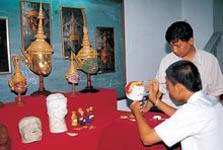 |
|
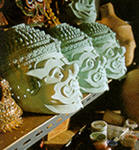 |
Khon Mask Making
Most visitors to Thailand have the opportunity to experience the masked "Khon" drama, a uniquely Thai version of the Indian "Ramayana" epic, with tales of gods of ferocious demons. Khon was originally developed as an exclusively Royal entertainment, popular at the courts of Ayutthaya and later of Rattanakosin. In addition to the exquisitely controlled grace and charm of the dance and its symbolic gestures (it takes over ten years to train a leading Khon actor), the most memorable features are certainly the gorgeous costumes with richly gilded crowns and colourful masks. Each character in the Ramayana, or Ramakian as it is known in Thailand, has a different costume and headdress. Of the leading roles the most easily recognised are the noble God - King, Phra Ram, the demon, Thotsakan, and the local monkey general, Hanuman. There are more than a hundred support characters and most of them wear different styles of masks and headdresses which are lavishly decorated. The making of these masks is an art form that highly specialised and there are only a very few craftsmen in Thailand who have mastered this skill. The making of each mask can take many days of detailed work. The first stage is the moulding of a plaster form to the size and shape of the actor's head. On to this is applied many layers of papier mache in order to build up the character's features. For the best masks a special tissue thin paper (hand - made from a tree bark called "khoi") is used. Up to 20 layers of khoi paper are glued on to the form, then the surface is dried and smoothed. The mask is then cut away from the form, the two halves begin rejoined by sewing with fine wire. A final layer of papier mache is added, holes made for eyes and mouth, and the decoration finished using paint, lacquer, gold leaf and coloured glass fragments. For the finest examples semi precious gems are used and real ivory for tusks and fangs.
|
|
|
|
Lakhon
Lakhon dance drama is less formal and actors, with the exceptions of monkeys, ogres, and other non-human, non-celestial beings, do not wear masks. Lakhon plots are drawn mainly from the Ramakian, the Jatakas, and folk stories, Khon and Lakhon costumes are identical, but Lakhon dance movements are more graceful, sensual, and fluid, the upper torso and hands being particularly expressive with conventionalized movements portraying specific emotions. Lakhon is subdivided into numerous variations, the major three being Lakhon Chatri, Lakhon Nok, and Lakhon Nai. Simplest of all in form and presentation,. Lakhon Chatri is often seen at popular shrines, such as Bangkok's Lak Muang (City Pillar) where dancers are hired by supplicants whose wishes have been granted to perform for the shrine deity. Lakhon Nai drama was originally presented only by court ladies in the palace. It was graceful, romantic, and highly stylized. Lakhon Nok plays, on the other hand, were performed outside the palace and acted only by men. Filled with lively music, off-colour humour, and rapid, animated movements, Lakhon Nok was the ancestor of the enormously popular Li-ke folk theater which is still a feature of many provincial festivals.
|
|
|
|
Likay
Likay or music drama is a traditional performing art
of central Thailand. Throughout its history,
The wik, the
|
|
|
|
Nang Yai
Nang Yai literally means "large shadow pupet".It is a high art form that originated the beginning of the 15th century A.D.. Nang Yai performance was a popula means of entertainment during Ayutthaya period and was mentioned in a poetry called Bunnovat Khamchan written by a Buddhist monk named Mahanak in around A.D. 175131758 or during the late reihn of King Boromakot. Nang Yai is originally a prototype of modern mask dance,which incorporates various episodes of an Indian epic called Ramakian(in Thai) or Ramayana (in Indian version).Nang Yai performance also adopts Ramakien as a leading story and the performance is episodic in each show. The performance of large shadow puppet is traditionally held in open spaces such as lawn or village dirt space. The main components of Nag Yai compose of a 16*6 white screen held by four bamboo or wood poles on each side. The screen is trimmed by red strip. Behind the screen strands a tinder or a bonfire lightened up to reflect the shadows of the puppet. During the course of the show there is a Thai music band that plays music in accordance with each episode of the performance. Also important in each shaow is dubber. The puppet figures are made from cow or buffalo hide perforated into different characters in Ramakien story. Each puppet weights approximately 3-4 kg. The biggest puppet is that chararterize a place, weighing around 5-7 kg. There is doubt that why large shadow puppet performer should be male and must be strong enough to hold the puppet through the course of performance period. Nang Yai can be found presently in all of Thailand. For example,in central Thailand,Nang Yai is performed at Khanon in Rachaburi,Wat Plub in Petchaburi,Wat Sawang Arom in Singburi,and Wat Pumarin in Samut SongKram,while in easternregion it can be found at Wat Donin Rayong Province.
|
|
|
Nang Talung
Nang Talung (Southern Thai Shadow Puppet Theater) is a form of entertainment that uses the shadow as its principle device, the same as Nang Yai (literally, big puppets). But the elaborateness and intricacy of Nang Talung is less, and the puppets are smaller in size than Nang Yai. What is important is that the telling of the story is local and follows the local patterns of simple speech that the villagers use. This is because the puppeteer recites extemporaneous Thai verse in the local dialect. There is a lively spoken exchange between characters that pleases the audience. One of the charms of Nang Talung is the group of clown characters who are well known, for example, Ai Khainui and Ai Si Kaeo. It is believed that these clowns are real living beings and that they have special personalities that are amusing. The puppeteer presents the lives of the puppets and puts them into the drama that is played out in a world which moves across the screen. He creates entertainment for people to watch. Nang Talung originated in the southern part of the country. Some people call it Nang Khuan because it originated in the village of Khuan Maphraw in Patlung province. But Nang Talung spread to other areas of the country, for example, in the North to Uthaithani province and in the East to Rayong province. The Northeast has this type of entertainment, but it is called Nang Phramod. We can concluded that Nang Talung is truly the entertainment of villagers in every area.
|
|
|
|
Hun krabok
Hun krabok are small-sized, bamboo rod puppets found in Thailand. The form originated in the late l9th century. Under court sponsorship a carver named Neng modeled figures on Chinese rod puppets. The iconography is borrowed from the older court shadow theatre (nang yai) which already existed in 1458, and doll puppets of the royal court (hun luang) which began before the 17th century. Thai shadow puppetry is, itself, derived from the Cambodian court shadow puppetry (nang sbek), which was in turn influenced by Javanese shadow puppetry (wayang kulit). The imagery of the Thai mask dance (khon) corresponds closely to that of the doll theatre. After carving the head from wood, the maker applies lacquer, papier mache, and paint. Next a bamboo support rod is attached to the neck, after which the figure is covered with a costume modeled on classical dancer’s clothing. Stories are sung in the style of lakhon nai, the female court dance drama, and accompanied by the sweet playing of the phipat, the Thai orchestra. Stories may be drawn from folktales or the Ramakien, the Thai Ramayana which tells of the kidnapping of Sida (Sita) by the ogre king, Thokosan (Rahwana). As she languishes in the garden of the Asoka tree in demon's kingdom of Alengka, Anuman (Hanuman), the white monkey and son of the wind god, brings her a sign from her husband, Phra Ram (Rama). With the help of the monkey army, Phra Ram fights a great battle to regain his wife, crushing the demon realm. Phra Ram is an incarnation of the Hindu god Vishnu. This story is popular on the Southeast Asian mainland and is associated with divine kingship. It was frequently presented at ceremonies of the Thai court and even today the Thai ruler takes the name of Rama upon accession to the throne. Puppet shows and masked dance were an important part of court entertainments, especially cremation ceremonies. Headdresses used on puppets and in dance drama borrow their form from Buddhist temple architecture with the upward extension related both to the head of the enlightened Buddha and the mountain/tree of life's triangular form. In recent years the hun krabok has been revitalized by the vibrant performances of Chakrabhand, Thailand's most noted painter who spends up to ten years preparing for a single performance. Several other styles of hun, doll puppets, are found in Thailand, but hun krabok is the most popular three-dimensional puppet genre.
|
|
|
|
Thai cinema
Thai cinema had long been demeaned as a low-grade cultural product by educated, urban audiences in Thai society. Bad plots, nonsensical scripts, exaggerated performance and poor production were appreciated only by rural, low-class audiences. Storylines often revolve around four generic formulae of comedy, horror, drama, and action in order to be prevented from box office failure. It is no surprise that the target of movie going culture in Thailand has distinctly been classified into two groups. While in Bangkok and very few major cities, there have been a steady investment in the building of modern multiplex cinemas, and audiences were offered a variety of films reflecting new tastes and quality films, in upcountry Thailand most theatres are still run-down stand alone cinemas, where audiences are offered movies only as mass entertainment. Besides, the Thai film industry is a society that has many times been involved with dark power, in comparison to other kinds of mass media - print or broadcasting - so young, energetic people preferred not to waste their time with it. There have, however, been two sparkling times in the eighty-three-year history of Thai cinema (since the first filmmaking Suvarna of Siam in 1923) when the industry enjoyed some major changes. Coincidentally, both periods were joined by young, emerging filmmakers who were able to attract educated, urban groups to go to the cinema. The first wave came in the 1970s when the intellectuals entered the film industry and made the so-called 'socially critical cinema'. This emergence needs to be understood in parallel to the change of the country's politics and culture, triggered by two major political upheavals: the student uprisings of October 14th 1973 and the attack on demonstrating students on October 6th 1976. In the same way as the youth counterculture spreading in the West in the 1960s, Thai students used pop culture as a medium to present their own ideology and standpoints. The movie was one of them, and social issues were taken as the key contents by those emerging filmmakers whose backgrounds transcended from university, political movements, journalism, as well as some from the advertising field. Some noted directors in this period included Prince Chatreechalerm Yukol, Vichit Kunavuthi, Euthana Mukdasanit, Manob Udomdej, and Permpol Choei-arun. A decade after that, the industry went down into the gloom with the flood of poor-quality teen flicks until 1997 when three television advertising men were coincidentally marching to make their first features. Pen-Ek Ratanaruang startled the Thai film world when his directorial debut, the quirky contemporary drama Fun Bar Karaoke (Fan ba karaoke, 1997) premiered in Berlin - and he thus became an overnight success. While Fun Bar Karaoke was waiting for local release, the industry also welcomed fellow newcomer Nonzee Nimibutr, whose nostalgic directorial debut Dang Bailey and the Young Gangsters (1997) was a huge hit with Thai audiences across generations and not surprisingly broke all-time Thai box office records. And near the year's end, yet another new director from the Thai advertising industry, Hong Kong-born Oxide Pang, entered the field with Who Is Running? (1997) The second new-wave however represents some distinct features far from those the first new wave had. While the earlier tackles the social and political contents, the latter freely goes into different directions, from the commercial-ridden genres to the highly-valued experimental. This in fact creates the merits of diversities in the present Thai film scenarios, better known as New Thai Cinema.
|
|
|
The music of Thailand
Since ancient times, the thai people have known how to make musical instruments or to copy the patterns of others and adapt them to their own uses. In fact, there are several kinds of musical instruments which the thais apparently devised before they came in contact with the culture of india, which was widespread in southeast asia before they migrated there. Later, when the thai people were establishing their kingdoms and had come into contact with indian culture, particularly with indian instruments which the mon and khmer cultures had absorbed first, they assimilated this musical culture into their own. From this contact, the thais creats several new kinds of musical instruments such as the phin, sang, pi chanai, krachap pi, chakhe, and thon, which are mentioned in the trihumikatha, one of the first books written in thai, and on a stone inscription from the time of king ramkhamhaeng of the sukhthai period. Some songs of the sukhthai period are still sung at present, such as phleng thep thong. During the ayutthaya period the instrumental ensemble was composed of four to eight musicians. Songs became much longer and singing technique was improved. Many ayutthaya songs were composed in a from of musical suite called phleng rua, which was a series of songs. Poets contributed lyrics in the form of short stories, mostly from the ramakian. Many ayutthaya songs are still employed in thai plays today. In the beginning of the bangkok period, after a long period of war, there was a remarkable revival of thai arts, especially music and drama. The size of the instrumental ensemble was enlarged to 12 musicians and several masterpieces of thai literature were produced as theatrical performances accompanied by music. Beautiful lyrics written by contemporary poets were fitted into melodies of the ayutthaya period. All thai musicians in the past received their training from their teachers, through constant playing and singing in their presence. With nothing else to rely upon except their own memory, it was only through much hard work that they gained their technical experience and practical knowledge in playing and singing. In all, there are about 50 types of thai musical instruments, including many local versions of flutes, stringed instruments, and gongs used for all kinds of occasions: festivals, folk theater, marriages, funerals, and social evenings after harvesting. His majesty plays also the saxophone that has been given him by benny goodman. Music plays an important part in the life of the thai royal fmily. His majesty the king bhumibol adulyadej is an internationally -recognized jazz musician with numerous orginal compositions to his credit, one of which was featured in a broadway show in the 1950's. Her royal highness princess maha chakri sirindron is an accomplished performer on several classical thai musical instruments, while her royal highness princess chulabhorn has made several popular music cassette tapes to raise funds for charity.
|
|
|
|
Thai kitchen
The thai food is extremely spicy, if observed a thai cook to attend to the preparation of a "gaeng pet" ( spicy curry ), sure you will surprise to add it to a handful of small chili greens (chili peppers), everyone of which would be enough to blow up the "farang" of the situation on the chair. But all thai plates are not thus spicy, exist also the cakes that comprise delicate creams in mature coconut and sugar confectionery wrapped in banana tree leaves, thus like numerous plates of moderately flavored "noodles". "tom yum" is a soup perfumed with the burning bush grass, it is practically the national thai soup. But the truth is that the thais loves the plates much spicy, there are about a dozen of types of chili, the most spicy is a orange quality called "prik kee nu luang". To part the chili, the base condiment of the thai kitchen are many thai herbs, the coriandolo (scattered fresh on nearly all the plates), the garlic, the basil the cardamonio, and a vegetable similar to the pea of the same family of the eggplant. They come moreover served also many sauces, the most common is the "nam pla". It is a likeable varying of ours salt, it is a sauce of fish fermented of the color of the tea. The main plate is a great tray of rice, encircled from five or six small trays of curry, verdure, fish, broth and similar. You put in a just flat a hillock of rice and after you can take a little of all the another in a small trays. The much famous is also the thai fruits always fresh of season. Inveterate consumers of spuntini, the thais eat when they have want, to any hour of the day and the night. Their philosophy relatively to the food is much simple: " eats when to the hunger ".
|
|
|
|
Fruit Carving
The art of fruit and vegetable carving (kae-sa-lak in thai) is performed in asian countries such as Korea, Japan and China, but thai culinary carving is arguably unsurpassed for skill and finesse. The best masterpieces can be found in Thailand. Thai cuisine involves the balancing of contrasting flavours, spicy and subtle, sweet and sharp. It is also concerned with aesthetic values for the Thais believe that food should please the eye as well as the palate. Fruit and vegetable carving is a venerable tradition which has been passed down form ancient times. Fruit and vegetable carving is considered one of the ten traditional Thai crafts. It is thus held to be an ancient art and is used in making food offerings for monks, entertaining guests, ordinations, weddings, and royal funerals. Thailand, the land of smiles, is famed the world over for the beauty and delicacy of its art and culture, which once experienced, make such an unforgettable impression upon visitors that they wish to come back time and time again. One thing that so delights them is the artistry of carved fruits and vegetables, an integral part of the presentation of delectable Thai food. The art of fruit and vegetable carving was originated in 1364 in Sukhotai when Lady Nang Nopphamat (Thao Sichulalak), who was the chief royal consort, decorated the floating lamp (krathong) with a profusion of flowers and birds, swans, rabbits and many other animals carved from fruits and vegetables. She made this krathong for the royal festival of loy krahtong celebrated on the night of the full moon of november of every year. A krathong is a tiny banana leaf boat shaped like a lotus flower and containing flowers, incense, lighted candles, and a coin. This floating lamp is floated on Thailand rivers for good luck. Nang Nopphamat carved fruits and vegetables in a variety of flowers and animals which were used to decorate the floating lamp, making it look like a huge water lily flower. When the King Phra Ruang saw what she had created, he appreciated this innovation and decreed it would be an art heritage of Thailand. Since that date, the art of vegetable and fruit carving has been performed by the ladies of the Royal Court. During the first reign of the Bangkok period, His Majesty King Rama I the Great held a fruit and vegetable carving competition at the festival of the twelth lunar month. Squashes were elaborately carved to serve as bowls for presenting sweet young rice to monks, and the trays on which the bowls were placed were splendidly adorned with flowers of many sorts carved from papayas colored with natural dyes. Fruit and vegetable carving was thus an art of the palace, and it was the palace which became as it were the university for Thai ladies. Girls of good family would be sent to the palace to be trained in the establishments of great ladies. This art was the preserve of chefs to royalty and the nobility, but can now be found in the buffet displays of some of the best thai hotels . The master carvers have taught their trade to the new generation. It was in the change in the form of government in 1932 during the Seventh Reign that a school of home economics was first established under Headmaster Yeuan Phanuthat . In 1934, Phraya Sarasatpraphan , the Minister of Education, gathered teachers from all over the country for a one-yeear training course in various arts among which was fruit and vegetable carving, and from that tme onward, the art has spread among people of all classes. The fruit carvers use a range of tools built for the job : very sharp pointed knives with double edged blades, knives with curved blades, gouges and cookie cutters. They must show patience, eye concentration and steady hands.
|
|
|
|
|
|
Thai Sweets
Eating is always an adventure in Thailand, but one part of the adventure that foreign visitors to the Land of Smiles may not venture very far into is the myriad variety of Thai sweets, called in Thai khanom. The main reason for this, perhaps, is the lack of recognition factor for all of those attractive little sweets in cups that look so appetizing on their bed of green banana leaf and all the rest. Thai cookbook writers have lamented about the eagerness with which the Thai people have abandoned aspects of their traditional customs and gone helter-skelter to take on the trappings of Western culture, but note with pride that the sometimes humble and sometimes elaborate Thai traditional sweets and desserts remain high on the preference list of indigenous Thais to the present day. It would be a misconception to say that these multitudinous products of this aspect of Thai cuisine are only desserts. The usual dessert after a Thai meal is a plate of attractively arranged mixed, cut fruit. It has been said that eating is the Thais national sport, and Thais are likely to nibble at one of the finger-sized sweets as a between-meal shack or take a bowl of one of the mixed sweets prepared with chopped ice as a refreshing treat on a hot tropical day. Some Thai sweets are also especially prepared for festivals such as the lunar new year, or as special treats to be offered to monks on special occasions. Thai desserts are usually simple and most of the ingredients can be found in any Thai marketplace. Basic ingredients for starting from scratch often include plain rice flour, sticky rice flour, or legume flour of various sorts. Sweeteners include cane sugar, palm sugar, coconut sugar, and the ubiquitous coconut cream. There is a whole class of khanom made from egg yolks, such as foi thong which are golden threads of egg yolk cooked hard in a sugar syrup flavored with essence of jasmine. Delicious, but not for those watching their waistlines or cholesterol levels. Sometimes aspects of khanom cooking can be exotic, such as used of the lowly pandanus leaf, which can be plaited into mats and other household items but finds its way into Thai khanom as a pleasing flavoring agent in anything from the small agar jelly snacks to ice cream. Methods of cooking or making Thai khanom are as diverse as the range of goodies themselves. For the agar jelly khanom, the cook may simply mix the ingredients and put them into molds, and some, like sangkayaa fak thong, a whole pumpkin filled with a coconut cream and egg custard, are steamed. Other kinds of khanom are deep-fried or cooked in syrup such as the egg yolk sweet. Some, such as khanom krok, little half circles of a layer of legume flour batter filled with another layer of sweetened coconut cream with a few chopped scallions added, are cooked on their own compartmented griddles over heat. Finally, Thai khanom are served at a temperature to suit any diner. On hot days have a khanom waan, where the diner chooses from among sundry sweet bits made of legume flour, or pieces of fruit or water chestnuts all displayed in separate jars or bowls, which the vendor puts in a bowl to order and adds sugar syrup, coconut cream, and a scoop of crushed ice. To sample a bit of everything just tell the vendor you want ruam mitr. Most finger sized khanom are served at room temperature, but on a slightly nippy cold season day try khanom tua daeng, a sweet concoction of kidney beans to which the diner can add a bit of sweetened coconut cream, or any other similar khanom which is served warm. The simplest Thai khanom, and often the most delicious, may be based on the various tropical fruits for which Thailand is famous. No one looks forward to the transition from the cold season to the searing hot season, except that the period of time mentioned heralds the season of ripe, savory mangoes. These are best enjoyed as khao niew mamuang , a dollop of sticky rice garnished with sweet coconut cream and a few roasted sesame seeds, and of course sections of sweet, ripe mango. Lucky are those that find a place which makes homemade mango ice cream, as an alternative. For those with a taste for the fruit, the same sticky rice is also served with bits of durian in season. The lowly banana finds its way into all manner of khanom. If a sweet shop offers a range of warm khanom, there might be gluay khaopode buad, a kind of pudding of bananas in coconut cream mixed with canned corn. Vendors can be found most anywhere selling simple gluay tarwd, deep-fried sweetened bananas, which make a tasty and filling snack. In some markets vendors offer a range of hand-wrapped homemade candies. A dark colored one might be gluay kloog ma-prao, a sweet made from bananas boiled up with sugar and coconut cream. One of those steamed snacks wrapped in leaves might be khanom kluay, a snack of bananas, coconut cream, coconut meat and sugar held together with rice flower. Another appetizing steamed offering teams bananas up with sticky rice, sweetened with sugar and the ubiquitous coconut cream, in khawtom mud sai gluay. In season, the succulent linchee or longan might be offered in a sweet coconut cream custard as well. One of the offerings to put into the iced khong waan sai naam kaeng is the meat of the strongly flavored jackfruit. A sweet custard-like khanom, called med khanoon is made with duck eggs, coconut cream and sugar. Finally coconut cream is not the part of the coconut to find its way into khanom. Sticky rice flour and grated mature coconut meat are mixed with sugar and essence of jasmine to make khanom tom daeng, sweet round balls rich with the flavor of coconut. The same grated coconut meat teams up with mung beans and condiments in a steamed sweet called thua paeb. The brief descriptions of fruit-based khanom here barely scratches the surface of varied world of Thai sweets. When your sweet tooth needs to be assuaged, go out and have a khanom.
|
|
|
|
Insects as food
Insects have traditionally been rich source of protein, calories, vitamins and minerals in the Northern Thai diet. They are also prized as delicacies. In fact, it is unusual for me to find an insect which is not eaten in one form or another by local people. Among the most popular are: cicadas, locusts, mantises, crickets and grasshoppers (deep fried), bamboobores . Again they are deep fried. In one Chaing Mai restaurant the menu describes them as "fried little white babies", giant water bug -steamed, also ground into a paste with chilli and eaten with sticky rice, weaver ants and their eggs (sticky rice is dipped into a mixture of ants, eggs and chilli), larvae which live in bamboos (barbecued), dung beetles (add a wholesome flavour to curries), pupae of silk moths and other moths and butterflies, wasps' and bees' larvae, termites are grilled and their eggs are a delicacy used to make a delicious soup, tarantula spiders (grilled), bowl of silk moth pupae: first remove the pupae from their cocoons, then boil them till soft with a pinch of salt, finally sautee them lightly. Tiny beetles are kept in a jar with cracked rice (like popcorn) and honey, keeping a thriving colony is supposed to bring prosperity to the household. Some people, however, also eat the beetles- live. As they've lived on a diet of rice and honey. Fried insect can be found in every food market in Thailand.
|
|
|
|
|
|
Drinks and drugs
In relation to the
costs of other consumer activities, drinking is quite expensive. The Thai
government taxes alcoholic beverages with something like 50%.
A a large bottle(630ml) of beer easily costs more than the half of the
minimum daily wage of a Bangkok worker.
According to the UN Food and Agriculture Organisation (FAO) Thailand is no.5
in worlds alcohol consumption, well ahead of France and Ireland.
Beers brewewd in Thailand:
Chang,Singha, Singha Gold, Amarit NB, Kloster, Carlsberg, Beer Chang,
Heineken
Singha dominated the Thai beer market for ages, but Charoen
Sirivadhanabhakdi's Chang Beeris now the most common beer in Thailand with
some like 60% of the market. The Thai word for beer is
bia. Draught beer is
bia sot
Legal Spirits:
Mekong (rice whisky)
Sang Thip (shugar cane rum)
and other labels
The Thai government lifted the alcohol monopole. Now everybody in the realm
can get a license to produce alcohol for as little as 2,50 USD a year.
That's a revolution.
Illegal Spirits (jungle liquor = Yaa dong):
between 10% and 95% ! of alcohol.
Available in smaller towns in almost every garage-type restaurant (not in
Muslim restaurants) under the counter. (don't know if still illegal, but
anyway, this law was never really enforced) Yaa Dong is actually an old
natural medicine ,roots and herbs are addeded to jungle liquor to enhance
flavor and color. You can indulge it as a tea, but to soak the herbs in
alcohol increases the fun factor and the blood circulation :-)). Don't
worry, nobody will get busted for a normal Yaa Dong.
But I heard reports that some Yaa Dong bars tried to alter the buzz by
adding one or the other special herb or mushroom. This might put a
police ociffer *hicks* in action..
Wines:
Poor domestic production. Imported wines from France Australia or USA are available in western restaurants and supermarkets.
Drugs:
marijuana, psilocybin, opium,heroin.
Opium, Heroin and Marijuana are widely used in Thailand, but it is illegal
to buy,sell,or posses these drugs in any quantity. (To possess opium for
consumption, not for sale, is legal among hill tribes in the northern
provinces.) But the average illicit drug among locals is MDA, (XTC) in Thai=
Ya Baa. It's usually imported from Birma, and than smuggled into the realm.
Too much money in that business that not everybody wants to have it's share.
Just keep your hands off, you are on a vacation not on an escape,... or, are
you?
Especially on the islands psilocybin containig mushrooms
(buffalo-shit-mushrooms) are sometimes sold to, or gathered by westeners. (
eg. Full moon Parties, Had Rhin, Koh Pa Ngan) The legal status of posessing
these mushrooms is questionable..
Watch out, be carefull,
Never run after it, let it all come easy.
Why to try something for the first time, what you intend not to take a
second time?
Never try to be smarter than the locals.
Penalties for drug offences are stiff, for using Marijuana you might end up
for one year in prison, while for using heroin, the penalty can be up to 10
years imprisonment.
For smuggling any amount of heroin you will be sent for lifelong
imprisonment.
For sumuggling heroin with the intention to sell you will be executed.
One man, one beer, no problem.
(fishermans proverb on Ko Thao)
|
|
|
|
Prostitution
In Thailand, prostitution was mentioned during King Rama I's reign. There was taxation of prostitutes and brothels called "tax for the road." When Rama V abolished slavery, some females slaves were turned over to men who started brothels. Prostitution was legalized in 1934 by Rama V. He expressed his concern about prostitutes who worked in gangs with men as their supervisors. The situation was prone to violence , and the threat if spreading venereal disease was great. Because of these dangers, Rama V allowed prostitutes to be registered so that they could receive regular medical care. Thailand remained under this act until 1960, when the United Nations declared the abolition of prostitution. The Thai government answered the UN policy by introducing " The Act to Deter Prostitution," replacing the 1934 law. According to this new act, no one is permitted to perform in the sex trade, either heterosexual or homosexual. A person who has transgressed the law will be find a maximum of 2000 baht ( about $50 U.S ) of sentenced to imprisonment for up to two months. Through this act, prostitution became illegal, which is to say, from the legal point of view, there are no prostitutes. Chalermpol Satthaporn, who has done research on prostitution in Thailand, found that after legal prohibition the number of prostitutes increased noticeably. Before the Act, 15 % of prostitutes were between the ages of fifteen and nineteen, but after the declaration if the Act, the percentage increased to 25 %. Also more women from rural areas became prostitutes. In provinces where there were military bases, the number of prostitutes also noticeably increased. Satthaporn also found that after the Act to Deter Prostitution, the number of people who were sentenced to imprisonment on charges of sexual harassment increased rapidly. Thailand's prostitution industry escalated dramatically during the 1960s when the United States established military bases here during the Vietnam Was. Even after the bases were dismantled, prostitution continued to spread in various guises - bar girls, singers, partners, and other "cover" occupations. Linked with economic instability and poverty is lack of education. The majority of prostitutes have had only four years of compulsory education. Farmers who have to struggle to survive economically will not be able to provide higher education for their children. Many farmers, being poor and uneducated themselves, do not have proper knowledge of family planning, and as a result have large families which created an added economic burden so serious that it falls also to the eldest daughters in the families to help out. This explains the high percentage of prostitutes who have many siblings, and are themselves the eldest daughters. Economic factors cause further problems: the break - up of the families; husbands deserting wives and children; and great numbers of rural poor who come to seek jobs in Bangkok, often with little success, as most of them are unskilled. The Government quotes successful economic growth from the rapid increase of the National Income Per Capita, in which the high income from prostitution is included. Thai prostitutes working abroad send home as much as 1.2 million dollars each year. Young women, tired of living in rural poverty with no future, find themselves ready and willing to take a chance at a new life promised by agents, who tactfully approach the girl's parents. Many of these young women have already been exposed to the dream of living in luxury as fed to them through television and other mass media. They want beautiful things and an easy lifestyle, Prostitution seems to them to be the only means available to actualize their dreams. Among teenagers especially it is very popular to follow the lead of one's peer group and friends. Dilok - Udomchai found that 37 % of the prostitutes joined the sex trade because they went along with the pattern set by their friends. Negative social values that denigrate women also contribute to the problem of prostitution in Thailand . Another aspect is the great emphasis Thai society places on virginity, which is to be preserved for one's husband. This overemphasized value has backfired. Among rape cases, for example, young girls think that once they have list their virginity, they have no value, and so they believe their only option is to become a prostitute. Other girls become prostitutes out of a sense of duty or obligation to their parents, to share the family's economic burden. When the family is in great debt resulting from failure in agricultural production of even simply from the father's gambling losses, the eldest daughters are asked to " sacrifice" for their parents and their younger siblings. There are cases where fathers sold and re - sold their daughters into prostitution to buy extra cows for farming. This is done iin the belief that children must show "gratitude" to their parents. It is interesting to note the resemblance in the reasoning of both prostitutes and mae jis for their life choices. Due to "gratitude" of obligation some women become prostitutes to repay their parents materially, while others choose to become mae jis to repay their parents spiritually, offering them the merit of their religious activities. It is common practice for Thai men to visit brothels to prove their virility. Men who do not do so are considered strange and suffer the possibility of becoming social outcasts. Many men say that they can not break the habit of going to prostitutes because they are so readily available and are a cheap source of entertainment. Too many Thai women also accept prostitution as a commonplace practice and some who do not wish to have a sexual relationship with their husbands have even encouraged them to see prostitutes. Safeguarding the welfare of Thai women and children is a national priority for the Government of Thailand. Of particular concern to the Royal Thai Government is the exploitation of children for the purpose of commercial sex. Young girls and boys too often are lured or forced into working in brothels and other sexually oriented establishments by profiteers. While child prostitution is hardly unique to Thailand, its existence is repugnant to the Thai people. Thai society and culture are based on close family ties and religious values that are in direct conflict with the forced exploitation of individuals-- particularly children--for sexual or any other purpose.
|
|
|
|
Psychoactive mushroom
Persistent references in the tourist industry literature call attention to the recreational use of psychoactive fungi in several resort areas of Thailand, including those on the islands of Koh Samui and Koh Pha-Ngan. On site observations and personal interviews indicate that numerous restaurants on the islands of Koh Samui and Koh Pha-ngan have been serving psychoactive omelettes, stews, soups, pizzas, teas, and blended juice beverages containing mind-altering, gilled fungi referred to as "magic mushrooms" and some of these commercial establishments also sell herb cookies mixed with psychoactive mushrooms and Cannabis ("ganga"). Purchase and use of foods containing psychoactive fungi occurs primarily among tourists and West German immigrants living on these islands. To a lesser degree, use also occurs among other foreigners as well as among some native people (male and female). In addition, some local children also harvest, sell, and consume these fungi, sometimes attempting to smoke the mind-altering mushrooms in bamboo pipes. Occasionally a number of restaurants also sell mushroom omelettes containing an artificial hallucinogen. This hallucinogen is psychoactively more powerful and potentially more dangerous than the psilocybian alkaloids that occur naturally in some of the wild or cultivated mushrooms collected locally. These fungi exhibited intense bluing reactions when handled, indicating the presence of psilocybine and/or psilocine. Seven collections of Psilocybe cubensis (Earle) Singer and/or Psilocybe subcubensis Guzmán and four collections of Copelandia species were harvested and sun-dried for herbarium deposit. These fungi are cultivated or occur spontaneously, often appearing in the decomposed manure of domesticated water buffalo (Bubalus bubalis) and at least three different species of cattle (Bos indicus, B. Quarus, and B. sundaicus). The psychoactive fungi are cultivated in clandestine plots, both indoors and outdoors, in the uplands and villages on Koh Samui by both Thai natives and some foreigners. The sale of psychoactive fungi directly to tourists and to resort restaurants for use in edible food items such as omelettes and soups is discussed in detail. The preparation and sale of mushroom omelettes adulterated with artificial hallucinogens in some restaurants is also discussed. In addition, the marketing of items such as hand painted T-shirts, post cards, and posters bearing mushroom related motifs in Thailand is described. The historical mind-altering effects of psilocybin are described as a voyage to the spirit world. These hallucinogenic effects are similar to those of LSD ; however, psilocybin is two hundred times less potent and also has a shorter duration time . Common physiological reactions include muscular relaxation, coldness of the limbs and abdomen, and dilation of the pupils. A somewhat stronger dose includes vision and mental hallucinations, powerful distortion of space, increased ability to visualize creatively, spontaneous detailed images and feelings of time distortion. These effects of psilocybin are often more pronounced in users who have used mushrooms before. So, the use of the mushroom causes a feeling of disconnection from reality and an altered state of consciousness . The nature of this trip depends upon the person taking it and the mood/state of mind that person is in. So your experience can be quite different from what you can read here or hear from other people. At first there some side effects might occur; unlike a hangover from alcohol afterwards, mushrooms give sort of a hangover before the actual trip starts. This includes a feeling of reduced temperature, gas and/or stomach discomfort and nausea. This is where a bad trip could start, remember this only happens when you come to think negative about it, these feelings then become stronger and exaggerated and this negative spiral influences the effects in the same way. This is more likely to happen to people who have a history of being depressed, schizophrenic or traumatized. So if you suffer from one of these, but also if you feel stressed, tensed or just not happy, do not take mushrooms. When taking a medium dose the trip takes about 4 - 6 hours and wears down gradually. The interval between hallucinations gets longer, until they disappear completely.
|
|
|
|
Siamese cat
The Siamese cat originated from Thailand, formerly known as Siam and in 1884 a small group of Siamese cats were given as a gift to a British Consul, General Gould, as he returned to the UK. In October 1985 his sister, Mrs Lilian Gould Velvey exhibited offspring from this group at the 17th Crystal Palace Show where they recieved much attention. In 1902 first Siamese cat fancier's club was formed in the UK with the first champion being 'Champion Wankee' who was born in Hong Kong in 1895. By the early 20th Century Siamese were appearing at shows in the USA and in April 1909 The Siamese Cat Society of America was founded. In the 1950s the Siamese in the UK and American reached its peak whilst in Thailand there were reports that only a few purebred Siamese were being bred. Mrs Dobrenchuk, a diplomat in Thailand, purchased three Siamese kittens and brought them with her on her return to the US. These cats were held in such high esteem in their native country that no one except the King and members of the royal family were permitted to own them. They were originally known as Royal points. Written records reveal that Siamese cats, in their country of origin, were venerated as guardians of the temples. When a person of high rank died, it was usual to select one of these cats to receive the dead person's soul. The cat was then removed from the royal household and sent to one of the temples to spend the rest of its days living a ceremonial life of great luxury, with monks and priests as its servants. These cats were reputed to eat the finest foods from gold plate and to recline on cushions made of the most opulent materials, which had been provided by the departed one's relatives in an attempt to receive good fortune and blessings. Once they became temple cats, they were supposed to have special powers and could intercede for the soul of the dead person. Years ago features such as crossed eyes and kinked tail were looked on as characteristics of the breed and many legends exist as to their origin. It was said that a Princess of the Royal House of Siam used her cat's tail as a ring-stand while she was bathing. The kink in the tail prevented the rings from falling off and being lost. Another legend accounts for both the cross-eyed feature as well as the development of the kink. Once, when all the men of Siam left their homes to defend their kingdom, just two cats - one male Siamese, Tien, and one female Siamese, Chula - remained in order to guard Buddha's golden goblet in the sacred temple. The male cat became pretty restless and, after mating the female Siamese, left her in order to find another priest to look after the temple. The female, apparently, was so overwhelmed by the responsibility of guarding the Buddha's treasure that she never once glanced away from the goblet, wrapping her long tail around its stem to prevent theft in case she should fall asleep. As time passed waiting for Tien to return with a new master, she could no longer forstall the birth of her kittens, who all arrived with the physical characteristics that she herself had acquired during her period as watchguard - a kinked tail and crossed eyes. Just occasionally, even today, kittens are born with these features - so the legends are.
|
|
|
|
Siamese Twins
The most famous set of conjoined twins were Chang and Eng, the men who originated the term "Siamese Twins". Eng and Chang were born in Siam (modern day Thailand) on May 11, 1811 to a Chinese father and half-Chinese, half-Malay mother. Thanks to their heritage, while growing up in Siam the boys were known as "The Chinese Twins". Despite the fact that their birth was initially believed to be an omen of the end of the world, they brought celebrity to their small village. Their mother refused to allow doctors to attempt to separate the boys, fearing that to do so would result in the death of one or both. Instead she taught them to stretch the tissue that joined them so that they could stand side-by-side rather than always face-to-face. In 1824, Scottish merchant Robert Hunter discovered the twins by accident while they were swimming. He introduced himself and became a friend of their family. Later he asked the Siamese government for permission to take the boys to Europe, but his request was at first denied. In 1829 Hunter and his associate Captain Abel Coffin offered money to the boys' mother for permission to take them abroad, then tried again with the government; this time they succeeded. In April, 17 year-olds Chang and Eng left for Boston, excited to see the world. After a successful and profitable tour of the States, the group then sailed to England where they became quite popular. They were extensively examined by doctors and visited by royalty. Unfortunately, their next planned stop, France, did not receive them quite so well; they were denied entry by the French government. The rest of Europe, however, was not closed to them, so they toured extensively, continuing to pack venues. In 1832 Chang and Eng broke off their arrangement with Captain Coffin (Mr. Hunter having sold his share of the rights to Coffin while they were in Europe) when they realized that he was taking the vast majority of the money received for their tours. This break led them to P. T. Barnum, with whom they toured until 1839, when they decided to quit the exhibition life and settle down. They chose Wilkesboro, North Carolina where they began the life of farmers. In 1839 they became United States citizens, but lacking last names they were simply listed as "Chang and Eng, Siamese Twins." In 1844 they decided to remedy that by petitioning to adopt the name Bunker, although it is not known for sure where this came from. Chang and Eng began to date Adelaide and Sarah Ann Yates, two of nine daughters of local farmer and part-time clergyman, David Yates. The townspeople disapproved, so Chang and Eng scheduled a separation surgery in Philadelphia. Their fiancées found out and quickly stopped the proceeding, and in April, 1843, Chang was married to Adelaide and Eng to Sarah Ann in a double wedding. During the course of their marriages, Eng fathered six boys and five girls; Chang seven girls and three boys. All were normal except for a son and daughter of Chang's who were deaf mutes. In January, 1874, Chang Bunker died after a severe case of bronchitis, possibly from a cerebral clot. Eng died shortly thereafter.
The apparel
The thais have a cleanest aspect and always in order, and also in the bidonville is rare to see someone of truly dirty and neglected. The mechanics, than to the end of a work-day are dirty of fat, they emerge from the bath of the evening like if they had not never touched a motor in their life. All the thais take a bath at least once day and often two. To say that someone is "mai rieb-roi" ( dirty), is nearly equally serious that to say that is "mai suparb " (rude), and often the two things correpond, the neglect in determined circumstances is often equivalent to the rudeness. Although between the young is fashionable to dress as the contemporarys european and americans and for the greater part of population that is simply "mai rieb-roi". In the same way for the traditionalist-thais, there are colours "educates" and colours "rude", a dress to brilliant colurs is acceptable in a young woman but it is not acceptable in a old woman, she would have to dress with colours pastel or dark inks. Sunday for example is only the day in which anyone can to dress of red without being considered "mai suparb".
|
|
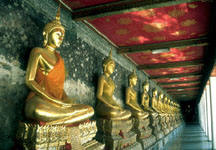 |
|
|
The Buddism
Buddhism plays a very significant role in the daily life of the Thai people. Since about 95% of the people in the kingdom of Thailand are Buddhists, Buddhism inevitably involves almost every occasion such as birthdays, marriages, moving to a new house, funerals, opening business offices and buying new vehicles etc.
Even though no concrete evidence can be found as to when and where Buddhism was actually established in Thailand, it is presumed that Buddhism was first brought to the country during the 3rd century B.C. when Theravada Buddhist missionaries led by Venerable Sona and Uttara were dispatched by the Buddhist Indian emperor Asoke and visited Suwannaphum or the present Nakhon Pathom. Once it was introduced, Buddhism became widely accepted and gained a permanent ground in the peninsula.
Briefly speaking, the Buddhist doctrine stresses the three principal aspects of existence:
dukkha = suffering
anicca = impermanence, and
anatta = non-substantiality
Thus the ultimate aim of Buddhism is Nibbana (or Nirvana in Sanskrit) which literally means the extinction of all desire and thus of all suffering (or dukkha). lt is an end, not only to suffering and action (Karma), but also to the cycle of rebirths that is existence.
Buddhism probably reached its height under the reign of King Li Thai of Sukhothai (King Ramkhamhaeng's grandson) as it was during his reign that the first Buddhist didactic literary work was written and was known as the ''Tribhumikatha''. Through the centuries Buddhism has been the main driving force in Thai cultural development. Thais of all classes subscribed to Buddhist doctrine. Although Buddhism is proclaimed as the state religion, all Thais are endowed with full religious freedom. Though Thai Constitutions stipulate that Thai Kings must be Buddhists Kings, however, must also be the Upholders of All Religions.
There are about 27,000 Buddhist temples across the country and majority of them are in the countryside. In Thailand, Buddhist monks are highly venerated for their chaste life, self-restraint, social benevolence and knowledge of spiritual practice. To allow people to have more time to devote to religious practices, all major Buddhist holy days are declared as national holidays. In addition, it has long been a Thai custom for Buddhist males over twenty years old to be temporarily ordained as Buddhist monks, usually during the annual Rains Retreat. Temporarily ordination, ranging from a few days to three months, is opened to everyone, even His Majesty King Bhumibol and Crown Prince Maha Vajiralongkorn have been monks for short periods. Their acts will continue a tradition for the new generations to come.
|
|
|
|
The Buddhist monks
"Tripitaka" (the instructions of buddha to pali), practice the meditation and they learn the virtu' of a free ascetic life from material possessions. A buddhist monk must also obey to 227 rules that govern all the minutiae of the daily life, beyond to refrain from the stealing, from the mentire and speaking idly, removing the life, from indulge to the sex, drugs, the lust and the frivolous divertiments. Also he cannot to possess nothing to outside of the garment and a bag of color saffron, the brass cup for the indispensable alms and some personal objects. He eats only two times to the day, the first time in the morning soon, (in fact the monks exits from the temples to the dawn in order to collect the food from the devout people), and the second time before midday. In spite of spartan life that is lead inside of the temple, a buddhist temple (wat) is not at all isolated from " the real world ". Many wat incorporate the schools of varied type, often is the only school of the village. The monks are free to travel from a temple to the other temple, but the period of the buddhist lent. Moreover the wat are opened to all those people who wish a retired life, the monk have also an important role in many rituals of the daily life, like the blessing of a new building, a birthday , a wedding or a funeral.
|
|
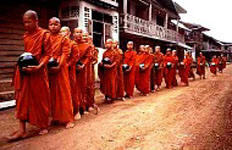 |
|
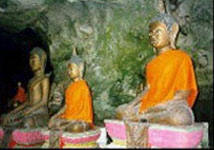 |
The merits
To the people, the wat and its monks offer to the opportunity of earn merits and the guarantee of greater recompenses after the dead, that is particularly important for the women, because although a time has existed an order of nuns (today is still possible to see some survivors of this order, they wear a garment white), this order has been abolish some years ago and the single way that remains to a woman in order to spiritually advance is through the purchase of merits. For this reason, the majority of the persons who participate to the sermons of the festive days is constituted from women. Beyond to giving food to the monks, the most diffuse way in order to acquire merits consists in to give own time for the maintenance of the temple or still better, in replacing an old and ruined temple with a new temple.
|
|
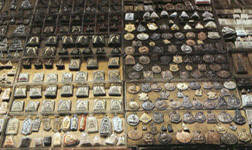 |
|
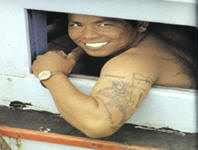 |
The belief
Nearly all thais of male sex, and also many women carry an amulet, of usual attacked to a gold or silver chain capacity around the neck and choose with greatest attention the just amulet, for the greater part consist in buddha images. Some have one average dozen quite, for protects from every type of danger, like street incidents, blows of firearm, bites of snake and any other imaginable disaster. In the province, the tattoos are considered most effective against the devil. Still today they consulted the astrologers in order to establish adapted moment in order to celebrate a wedding, in order to undertake a travel, for to move in a new house, and even for to promulgate a new constitution. Many of the not buddhist beliefs have origin brahmin and still today brahmins clergymens, pertaining to approximately four thousand families brahmin of the country, occupy a prominent place in the religious life thai and officiate in many important ceremonies. One of the most popular and spectacular of these is that of the plowing that has place in the month di may, also the wedding ceremony thai is nearly entire of origin bramina and can to say the same for many rituals relative to the funerals.
|
|
 |
|
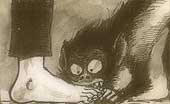 |
|
Thai ghost
Pee fa and teparak
Always found in forest, caves, river or trees. Sometimes called tewada or chow (both words mean angle). This kind of ghost is classed as natural ghost.
Pee nang tanee
This
ghost is a beautiful-young lady ghost and has same miracle power's pee nang
ta-kean, but haunt banana plant.
Always appear in full moon night, in the part, thai people do not
admire to plant this kind of banana.
Pee nang ta-kean
People rumor that this ghost is a beautiful-young lady ghost, haunt hopea
tree (especially old tree).
So in the part, thai people do not admire to plant hopea.
Pee gong goy
Believe that this ghost is a kind of sylvan spirit, like to suck dry at foot
of man. Sometimes call 'spirit of an uncremated dead', body is not distinct,
always see in wilderness.
Pee
pob (ogre)
This ghost is never
recovered, always haunt man's body and eat up his entrails then leave him.
In publicity, it pretend to be ill, but it steal uncooked meat from
villagers to eat at night.
|
|
|
|
The spirits
The word thai that means spirit is "phi" and the quantity of spirits is immense above all in the campaigns, exceeding by far, is believed, the entire world-wide population and for some reason, malignant spirits seem to be all of feminine kind. To the outside nearly all the houses there is one house of the spirits in miniature arranged on a pole, in a place chosen after complicated considerations of astrological character. In simple houses, the small house can to be one common structure of wood equal to the typical houses thai, in the great buildings, the hotels and the palaces for offices, can to be a processed and very small temple of cement, painted and decorated. Brightly-coloured ribbon is wrapped around trees or other objects. In all the cases, the stay place of the spirits of the place, that they have the power to favor or to torment the inhabitants is adorn of offerings propitiatory consisting in food, fresh flowers and incense rods. If the building comes hit from calamity or bad fortune, is necessary to call an expert (often a buddhist monk) he consult the spirit in order to understand where is the problems. For the thais not there is contradiction between the sideboard in the spirits and the buddhist faith, their large and unwrapped tolerance render they possible to accept and to make to cohabit whichever practical religious. The Thai people are known for being superstitious.
|
|
|
|
|
The elefant
Sacred to the buddha and symbol of the thailand, the generous giant, employee until yesterday in the great forests of teak, has been declass from the law against the deforestation to simple attraction for the tourists. To man memory, the asians have always tamed the famous elephans maximus, the most large and the most strongly land mammal not still extinguished but this pachyderm was not only a hard work animal: in the course of the centuries, thais, burmeses and khmer have done infinite battles with their army of elephants. That elsewhere for the monarchs were the real stallions or the hawks, for the king of siam are always been the "chang puak", the white elephants . It has from young introduces spots rose on the forehead or on the ears and has eyes and nails white , who finds a copy of this type, in thailand have literally the duty of delivered to the real palace. Is not important if the zoologists speak about " albinism ": here convinced people is that a great number of white elephants assures to the king a fortunate regency. The current monarch educated in Switzerland possesses nine white elephants.
|
|
|
|
Vehicles in Thailand
Tuk Tuk
Known as sam-lor are colored mototaxi to three wheels, similar to our "bee", with two posterior seats with one they personality'. These " fast runners " are truly indomitables, make to squeak the wheels in order to compete with an other tuk-tuk and are thus brave to defy the city buses for the first place to the traffic-light. The tuk-tuk always succeed to find the possible road for to avoid the traffic, but you can take only for short distances.
The Samlor
Just a few decades ago, motor vehicles were uncommon in Thailand, and people traveled by walking or riding a boat, elephant, or cart. Then, some enterprising inventor created the pedal taxi with one driver pedaling a converted bicycle with a small seat in the rear. In Thailand, these "samlors" can still be found on the streets, and they seem to be the preferred mode of transportation for many older women returning from their early morning shopping. Of course, many tourist like them as well.
Song thaew
The most common type of public transportation has to be the "song thaew". Named for the two benches found in the rear passenger area, the song thaew is a pickup truck converted for carrying passengers and some cargo. These vehicles are regulated and licensed by the government, and the color of the paint indicates the general route or purpose that each song thaew follows. In Chiang Mai, red song thaews roam the city and are free to travel anywhere, while white song thaews travel between Wararot Market and the suburban city of Sankampaeng, and yellow song thaews usually travel from Chiang Mai to outlying cities, with some traveling as far as 100 km. or more.
Tourists Travel in "Wans"
The multi-passenger van (pronounced "wan" in Thai) can be found wherever tourists can be found, and they often serve as small, air conditioned, inter-city buses on some rural routes. Almost every automobile manufacturer makes vans in Thailand, as both the usage and demand for these vehicles is high. The average van is equipped with two seats in front (driver and guide) plus three rows of three seats for the passengers/tourists. Large people should try to sit in the first of these three rows, because access to the back two rows is a little cramped. With much of the interior room being used for people, the internal cargo/luggage capacity is not large, and so large luggage may have to ride on top of the van.
Family Transportation, Thai Style
Here is an ingenious way to transport goods or your family on small or obstructed roads. These converted motorcycles have a large sidecar that can carry cargo, or can be equipped as a mobile kitchens, barbecue, iced fruit stand, and the like. Many of these vehicles have a somewhat disreputable appearance, leading to the suspicion that this conversion is the fate of older motorcycles, but occasionally you can see a nice, new conversion job that is the proud but inexpensive means of transport for some Thai family or small business.
|
|
|
|
The orchid
The wild orchid is the flower symbol of the thailand. In the 800 botanist and travellers made madnesses in order to discover new variety to import in europe and in order to penetrate the segret of its voluptuous behavior sensual. The delicate and sensual shapes and the complexity of the erotics games which the orchids abbandoned is the consequence of their fight for the reproduction. Thailand is the world’s largest exporter of fresh orchids and some of them can be discovered in various orchid nurseries and shops in Phuket and other towns. As it is a delicate matter to grow orchids (some species even need about 4 years to blossom first time) the nurseries usually specialize just on a couple of species / hybrids. Generally speaking, orchid species are taboo for export, orchid hybrids are the ones raised in the nursery. For “take away” of orchids, there are 3 ways, either you take the whole orchid plant in the pot(last for long time with proper treatment) also in a different climate like Europe etc., take only the orchid cut flower (right before you leave) the cut flowers stay ok for up to 1 month in a colder climate with proper treatment, or take the orchid “seedlings in the bottle” (e.g. at the nursery mentioned below) and handle them according to the instructions. What you need with orchids in general is a sense for beauty and patience, the flower need a lot of time, care and ....maybe call it love.
|
|
|
|
Gems
One of the most pervasive scams in Thailand is the Thai gem scam. Typically, a tourist meets a friendly Thai at a tourist attraction who eventually offers to take them to a "government" gem stone shop where the tourist is told about how they can sell Thai "blue sapphires" or other gems back home and make a 100% profit. It is all lies, of course, and the tourist ends up with a pocket full of overpriced gems. Like Thais themselves, the scam is low-key and the touts are friendly rather than pushy. A rule of thumb for Thais is that "real" Thais do not just walk up to strangers and strike up a friendly conversation. Thais typically "speak when spoken to." If you are approached at a tourist attraction by a friendly fellow who just walks up and starts speaking to you, watch out!
How it is done
This is a by-the-numbers
scam. Most people have the exact same experience. It usually goes something
like this:
1. You are riding in a tuk-tuk
2. The driver tells you that wherever you are going is closed for
some reason.
3. The driver tells you he is specially trained to be helpful to
tourists.
4. You are told the government has launched a promotion to sell gems
to tourists.
5. In the course of riding around with the "friendly" tuk-tuk driver,
you "accidentally" meet a well-dressed young man or an older, distinguished
man.
6. The younger man claims he is a student. The older will claim he
works for the government and shows you his government ID. (Thai
IDs mean nothing. They are readily available for a small fee to anyone.)
7. The person you meet independently confirms the story the tuk-tuk
driver told. (This is a nice touch.)
8. Eventually you ask to be taken to the "government" jewelry house
and are told that you can make 100-150% profit by reselling the gems back
home. It seems okay since the seller writes something like "if everything is
not ok we will offer a full refund" and puts an official looking stamp on
it.
9. You've now been cheated by one of the oldest and most openly
practiced scams in Thailand.
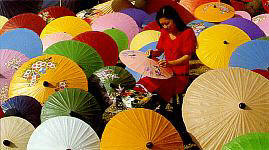 |
|
|
|
The handicraft
In Thailand the webbing of the silk has been practiced for centuries, but to a sure point, this ancient industry is seemed to disappear. In 1976 the queen has given the way to a program in order to sponsor, between the other, centers where to instruct the new weavers in the use of the filarello and of the chassis by hand, as it made oneself the old times. Today you can admire the result, there are several quality of silk: the silk " mudmee ", whose characteristic geometric reasons are obtained by means of a particular dye procedure of the spun one, the silks transparent and veiled and those for dresses or carpets. As the silk also the tek wood has nearly risked the extinction. Today no piece of this exotic wood can to come exported before being transformed in a finished product, the result is that the talent of craftsmen thai is hour be put in evidence, that it is a miniature of elephant of a little grammes, or a statue of high natural largeness two meters and to heavy like a true pachyderm, the precision of the details is the characteristic element that distinguishes the meticulous job of these sculptors of the wood. The engravers thais are also famous for their ability in the constructing furnitures and pieces of furnishing, some of which with realistic scenes of thai life scrupulously carved in the wood. The wood of thus precious teak isthat no piece comes wasted and even the small fragment comes used for the varnish objects. The natural irregularity of the wood come then puttied with clay and levigate until rendering the surface smooth. Then, during a period of various months, its come applied seven enamel layers and, in order to end, a reason decorative in gold sheets comes added. An other example of the creativity of the thais is demonstrated from the parasol and fans painted by hand, today come used above all like objects decorative. Its were been born originally like articles from gift for the monks. Still they are made to the way original with bamboo, paper, rayon or cotton. The paper comes extracted from the rind of the mulberry trees, the fillets are prepared by hand and the holes come practiced with punching-press set in action to pedal; in order to end its come by hand painted with rocky reasons or mythologicals reasons. In the north of the thailand there are stores of handicraft tribal where the handicraft woven fabrics can be acquired, singular apparels and accessories of the tribes of mountains. Also black velvet tapestries "kalaga", adorned in relief with metallic filaments, sequins and precious stones are a product of thai handicraft . The name kalaga means " curtains alien ". Some of these ornamental cloths can to be five meters of length, others are adapted in order to make pillows, pictures and shoulder-bags .the figures shine on the kalaga describe to scenes and personages of ancient sansckrit legends, the ten buddha lives and the vicissitudes mythologicals of the "ramayana". Also the ceramics bencharong came produced exclusively for the king of the thailand. These objects are of enameled china from the luminous symmetrical decorations. The bowls, the vases are hem in gold 24 kt. The boxes for the betel walnut have a place of honor in the history of the thailand. The trays door betel make part of the objects in use in the real courts and are the wedding present handed on of generation in generation near the rural families.


